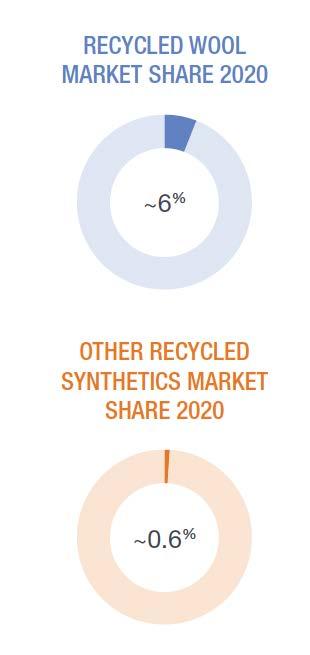Product Analysis Project:

Child´s Polo Shirt
 by Mae Woelfle, N1011985
by Mae Woelfle, N1011985


 by Mae Woelfle, N1011985
by Mae Woelfle, N1011985
The aim of this report is to analyse all details of an already finished garment, realising how many decisions must be made to end up with a best-selling garment and how minor misunderstandings with other people working on the product can have major impacts. The product is the most important part in the fashion industry and needs to be exactly right to generate as much profit as possible for the retailer.

Fig.: 1 Fig.: 2 Fig.: 3 Fig.: 4 Fig.: 5 Fig.: 6 Fig.: 7 Fig.: 8 Fig.: 9 Fig.: 10 Fig.: 11 Fig.: 12 Fig.: 13 Fig.: 14 Fig.: 15 Fig.: 16 Fig.: 17 Fig.: 18 Fig.: 19 Fig.: 20 Fig.: 21 Fig.: 22 Fig.: 23 Fig.: 24 Fig.: 25 Fig.: 26 Fig.: 27 Fig.: 28 Fig.: 29 Fig.: 30 Fig.: 31 Fig.: 32 Fig.: 33 Fig.: 34 Fig.: 35 Fig.: 36 Fig.: 37 Fig.: 38 Fig.: 39 Fig.: 40 Fig.: 41 Fig.: 42 Fig.: 43
p.1-16 p. 4-7 p. 4 p. 4 p. 4 p. 5 p. 5 p. 6 p. 6 p. 6 p. 6 p. 6 p. 6 p. 6 p. 6 p. 6 p. 6 p. 6 p. 7 p. 7 p. 7 p. 7 p. 7 p. 7 p. 7 p. 8 p. 8 p. 8 p. 8 p. 8 p. 8 p. 8 p. 8 p. 8 p. 8 p. 8 p. 9 p. 9 p. 9 p. 9 p. 9 p. 9 p. 9
• Authors own, Boys Polo Shirt Front, 2022
• Authors own, CAD coloured 2022
• Authors own, CAD After care symbols, 2022
• Authors own, Boys Polo Shirt Insides, 2022
• Authors own, CAD B/W, 2022
• Authors own, CAD B/W with measuremnts 2022
• Authors own, Table of measurments, 2022
• Fashionary, 2020. Textilepedia. Fashionary International Ltd, pp. 56-57, [table].
• TextileExchange, 2021. The Global Preferred Fibre Market 2020. [illustration] Available at: <https://textileexchange.org/ preferred-fiber-and-materials-market-report/> [Accessed 5 May 2022].
• Authors own, Fabrics, 2022
• Authors own, Collar detail, 2022
• Authors own, Seam detail, 2022
• Authors own, Embroidery detail, 2022
• Authors own, Interlining detail, 2022
• Authors own, Care label, 2022
• Authors own, Logo label, 2022
• Authors own, Hangtag, 2022
• Authors own, Packaging 2022
• Mashiata Group, 2022. Yarn Dyeing. [image] Available at: <http://www.masihata.com/gallery-mega.html#3> [Accessed 10 May 2022].
• Fashionary, 2020. Textilepedia. Fashionary International Ltd, pp. 200-201, [table].
• Pantone, 2022. Kids Polo Shirt Colours. [image] Available at: <https://connect.pantone.com/#/picker?pantone Book=pantonePastelsNeonsUncoated> [Accessed 6 May 2022].
• Knit Concern, 2019. Yarn Dyeing. [image] Available at: <http://knitconcern.com/yarn-dyeing.htm> [Accessed 3 May 2022].
• Authors own, Fabric detail, 2022
• Authors own, All Cut Knit Illustations, 2022
• Knit Concern, 2019. Knitting. [image] Available at: <http://knitconcern.com/Knitting.htm [Accessed 3 May 2022].
• Authors own, CAD B/W, 2022
• Eberle, 2014. Clothing technology. Europa Lehrmittel, pp. 147, [image].
• Authors own, Ply Illustations, 2022
• Authors own, Fabric Presentation Illustations, 2022
• Authors own, Spreading Illustations, 2022
• Eberle, 2014. Clothing technology. Europa Lehrmittel, pp. 149, [image].
• Knit Concern, 2019. Cutting. [image] Available at: http://knitconcern.com/cutting.htm [Accessed 3 May 2022].
• Knit Concern, 2019. Spreading. [image] Available at: http://knitconcern.com/cutting.htm[Accessed 3 May 2022].
• n.d. stitch types & sewing thread requirement. Amann Group, pp.5-9, [image].
• Eberle, 2014. Clothing technology. Europa Lehrmittel, pp. 159, [image].
• Fashionary, 2017. Fashionpedia. Fashionary International Ltd, pp. 282, [table].
• Knit Concern, 2019. Embroidery. [image] Available at: < http://knitconcern.com/embroidery.htm > [Accessed 11 May 2022].
• Knit Concern, 2019. Embroidery preperation. [image] Available at: <http://knitconcern.com/embroidery.htm> [Ac cessed 11 May 2022].
• Authors own, Embroidery inside 2022
• Authors own, Embroidery close up, 2022
• Pantone, 2022. Kids Polo Shirt Colours. [image] Available at: <https://connect.pantone.com/#/picker?pantone Book=pantonePastelsNeonsUncoated> [Accessed 6 May 2022].
• Authors own, CAD of embroidery, 2022
• Knit Concern, 2019. Quality Control. [image] Available at: http://knitconcern.com/quality-assurance.htm [Accessed 11 May 2022].
Fig.: 44 Fig.: 45 Fig.: 46 Fig.: 47 Fig.: 48 Fig.: 49 Fig.: 50 Fig.: 51 Fig.: 52 Fig.: 53 Fig.: 54 Fig.: 55 Fig.: 56 Fig.: 57 Fig.: 58 Fig.: 59 Fig.: 60 Fig.: 61 Fig.: 62 Fig.: 63 Fig.: 64 Fig.: 65 Fig.: 66 Fig.: 67 Fig.: 68 Fig.: 69 Fig.: 70 Fig.: 71 Fig.: 72 Fig.: 73 Fig.: 74 Fig.: 75 Fig.: 76 Fig.: 77
p. 9 p. 9 p. 9 p. 9 p. 10 p. 10 p. 10 p. 10 p. 10 p. 10 p. 10 p. 10 p. 10 p. 11 p. 11 p. 11 p. 11 p. 11 p. 11 p. 11 p. 11 p. 13 p. 13 p. 13 p. 13 p. 13 p. 13 p. 14 p. 14 p. 14 p. 14 p. 14 p. 14 p. 14
• Fashionary, 2019. Business Fashion Manual. Fashionary International Ltd, pp. 77, [illustration].
• Knit Concern, 2019. Checking. [image] Available at: http://knitconcern.com/quality-assurance.htm [Accessed 12 May 2022].
• Knit Concern, 2019. Packaging. [image] Available at: http://knitconcern.com/quality-assurance.htm [Accessed 12 May 2022].
• Authors own, Shirt in poly bag, 2022
• Authors own, Global supply chain, 2022
• TextileExchange, 2021. Top 10 preffered cotton countries. [table] Available at: <https://textileexchange.org/preferred-fib er-and-materials-market-report/> [Accessed 10 May 2022].
• Authors own, Google maps screenshot of rail route from India to Dhaka, 2022
• H&M, 2022. UK shop locations. [Screenshot] Available at: https://www2.hm.com/en_gb/customer-service/shopping-at-hm/ store-locator [Accessed 10 May 2022].
• H&M, 2022. Different online markets. [Screenshot] Available at: https://www.hm.com/entrance.ahtml [Accessed 10 May 2022].
• H&M, 2022. Supplier List for Polo Shirt. [Screenshot] Available at: tps://www2.hm.com/en_gb/productpage.0933591004.html [Accessed 25 April 2022].
• Shipmap.org, 2019. Sea freight routes. [Screenshot] Available at: https://www.shipmap.org [Accessed 10 May 2022].
• Goolge Maps. The Knit Concern. [Screenshot] Available at: https://www.google.com/maps/place/Knit+Concern+Group/ @23.6409669,90.5117482,17z/data=!3m1!4b1!4m5!3m4!1s0x3755b1684d2848e9:0xd4d8ee3f2d411359!8m2!3d23.6409669! 4d90.5139369 [Accessed 10 May 2022].
• Knit Concern, 2019. Dye House. [image] Available at: <http://knitconcern.com/Dyeing.htm> [Accessed 12 May 2022].
• Knit Concern, 2019. [Screenshot] Available at: <http://knitconcern.com.> [Accessed 25 April 2022].
• CleanClothes.org, 2019. Still un(der) paid. [table] Available at: https://labourbehindthelabel.org/report-still-underpaid-howthe-garment-industry-failed-to-pay-its-workers-during-the-pandemic/ [Accessed 6 May 2022].
• H&M, 2022. Supplier List for Polo Shirt. [Screenshot] Available at: https://www2.hm.com/en_gb/productpage.0933591004. html [Accessed 25 April 2022].
• Knit Concern, 2019. Garment Assembly. [image] Available at: <http://knitconcern.com/apparel-sewing.htm> [Accessed 3 May 2022].
• Knit Concern, 2019. Training. [image] Available at: http://knitconcern.com/training-center.htm [Accessed 3 May 2022].
• Knit Concern, 2019. Knitting. [image] Available at: http://knitconcern.com/Knitting.htm [Accessed 3 May 2022].
• Authors own. Table of UK, Swedisch and Bangladesh national holidays, 2022
• Authors own. Critical Path, 2022
• Authors own. Marlow´s hierarchy of needs illustation, 2022. Reference at: https://www.thoughtco.com/maslows-hierar chy-of-needs-4582571 [Accessed 13 May 2022].
• Authors own, Remanufacturing Illustation, 2022. Reference at: Circular Fashion by Blum, p.92, 2021.
• Authors own, Basic clothing functions Illustation, 2022. Reference at: Clothing Technology by Eberle, p.48, 2014.
• TextileExchange, 2021. Prefered Fibres and Material Market Overview. [illustration] Available at: <https://textileexchange. org/preferred-fiber-and-materials-market-report/> [Accessed 7 May 2022].
• TextileExchange, 2021. Recycled Cotton. [illustration] Available at: <https://textileexchange.org/preferred-fiber-and-materi als-market-report/> [Accessed 7 May 2022].
• TextileExchange, 2021. Recycled Polyester. [illustration] Available at: <https://textileexchange.org/preferred-fiber-and-mate rials-market-report/> [Accessed 7 May 2022].
• H&M, 2022. Polo Shirt. [Screenshot] Available at: https://www2.hm.com/en_gb/productpage.0718081030.html [Accessed 14 May 2022].
• Authors own, Costing Table, 2022. Reference at: Costing Lecure by Love at Nottingham Trent University, 2022.
• Authors own, Thread usage, 2022. Reference at: https://www.amann.com/company/download-center/, 2022.
• Authors own, TBL, 2022. Reference at: https://online.hbs.edu/blog/post/what-is-the-triple-bottom-line, 2022.
• CleanClothes.org, 2019. [image] Available at: https://cleanclothes.org/poverty-wages [Accessed 6 May 2022]
• Statista, 2020. [table] Available at: https://www.statista.com/statistics/987707/bangladesh-export-value-garments/ [Ac cessed 15 May 2022]
• Smart Freight Centre, 2022. [image] Available at: https://www.smartfreightcentre.org/en/smart-freight-solutions/ [Accessed 15 May 2022]
An in-depth analysis of this H&M boys polo shirt, starting with the fibre and covering all aspects and information needed to replicate:
» garment description » colourways » after care » inside details » measurements » fibre composition » fabrication » trims » other components » spinning » dyeing » knitting » spreading & cutting » stitches » seams » sewing machines » embroidery » quality assurance » packaging » global supply chain » manufacturer » critical path

Product Development Project: Product Analysis of a child´s polo shirt
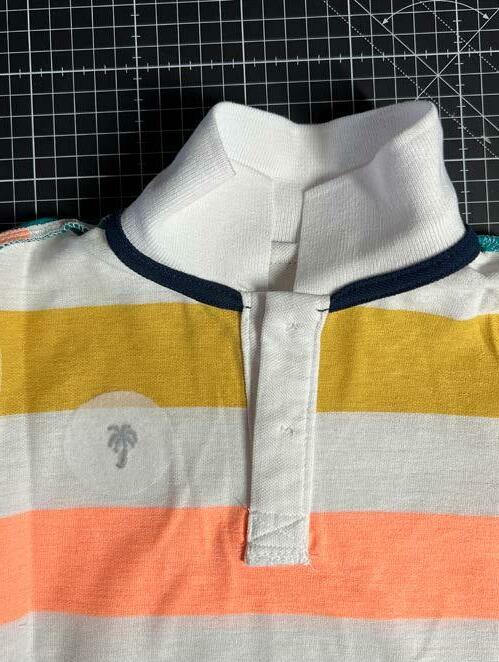

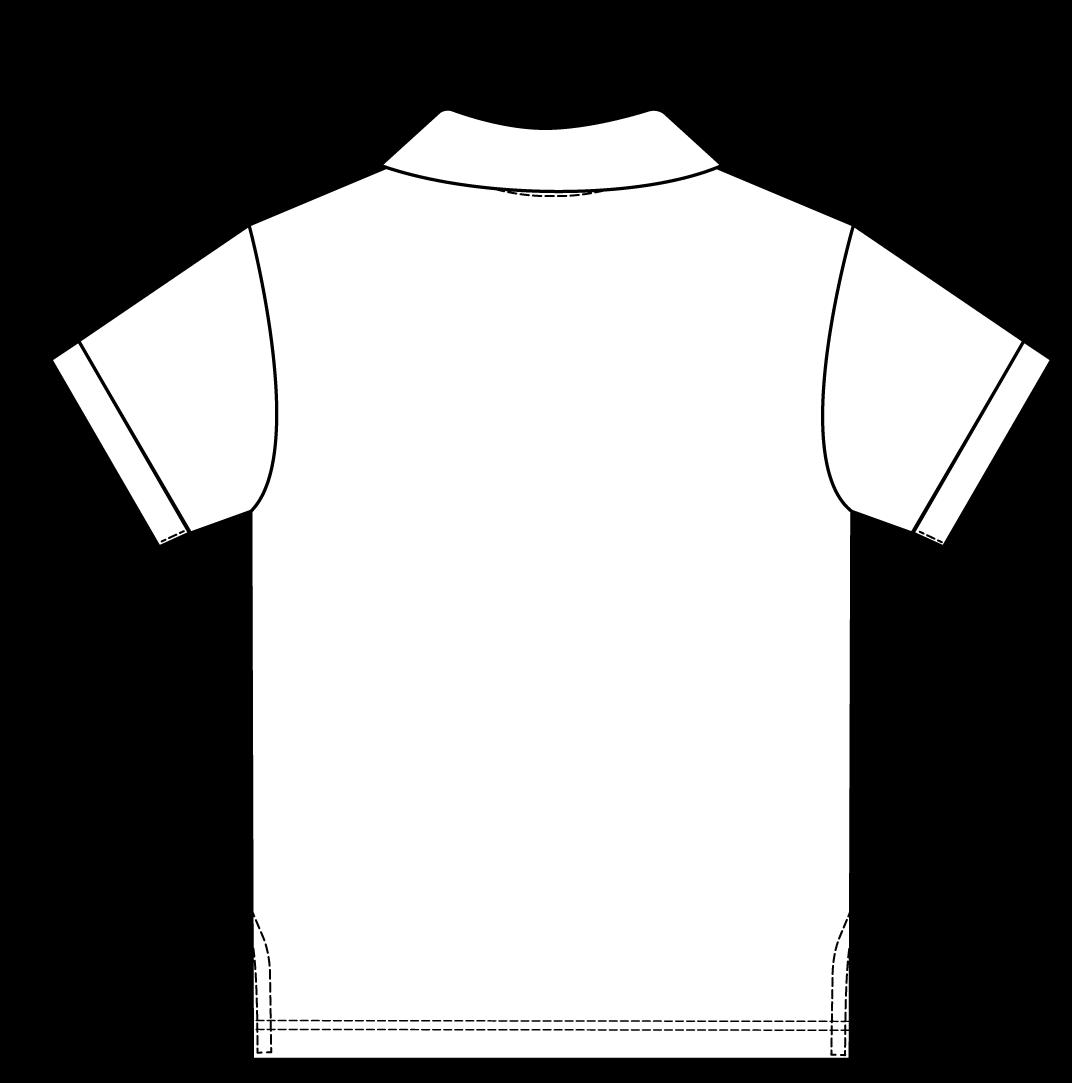

Fig.: 5





Category
Style
Season/ Collection 0933591004 Spring Summer 2022 Cotton piqué polo shirt 60% Cotton 40% Polyester
RRP 7.99 T-Shirt & Shirts 11/2 - 2Y 2-4Y 4-6Y 6-8Y
Composition
Department Boys 2-8Y Available Sizing
“Polo shirt in cotton piqué with a ribbed collar and button placket. Small, embroidered detail on the chest, short sleeves with narrow trims, and short slits in the sides of the hem. Slightly longer at the back.” (H&M Product Description 2022)
» standard fitted classic kids’ polo shirt » made from a weft knitted piqué and rib knitted details like collar and sleeve hem
» short, attached button placket with two 4-hole plastic buttons and 2 machine square buttonholes
» ribbed collar, no collar stand, ribbon attached
» woven brand and size label in the back neck, care label inside seam

» the straight hem is shorter in the front with short side slits on both sides with 90° corners
» small, embroidered palm tree motive on the right breast area
AVAILABLE CLOURWAYS:
» Light orange/ Striped
» Dark blue/ Block-coloured » Blue/ Striped
The fabrication stays the same, but all options will be knitted differently due to the yarn dyed stripe effects.
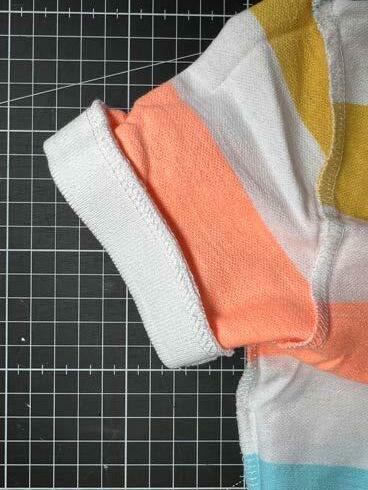
The placement of the colour blocks on the image of the H&M website are different from my sample shirt, suggesting that the print pattern is placed from the hem and ends on different stripes depending on size.

(H&M, 2022)
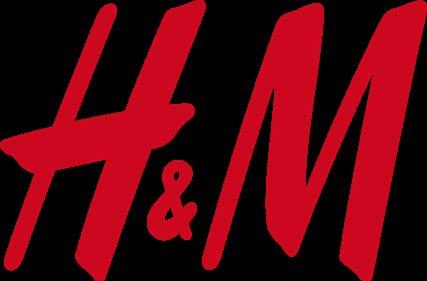
(Textile Labelling: ISO 3758; ASTM D5489)

Fig.: 3
» Machine washing at max. 40°C program for coloureds
» Best for coloured garments in cotton/polyester blends
» Do not bleach
» Best for sensitive, coloured garments
» Use a bleach-free detergent
» Do not tumble dry
» Garments might deform or shrink in a tumble dryer
» Iron at medium heat
» Steam with care and do not stretch garment
» Two dots indicate a maximum temperature of 150°C
» Iron embroidery under a cloth
» Do not dry-clean
» Indicating recommendations for professional cleaning
Composition 60% Cotton 40% Polyester
11/2 - 2Y 2-4Y 4-6Y 6-8Y
REF. DESCRIPTION
MEASUREMENT for Size 4-6Y in cm
1 Chest - 2cm below armhole, measured straight across, edge to edge 33cm 0mm 2 Waist - 11cm below armhole, measured straight across, edge to edge 33cm 2mm 3 Front length - measurement taken from HPS/SNP straight down to the front hem 45cm 0mm

4 Centre back length - from the centre back neck, measured straight down to the back hem 44cm 1mm
5 Hem - measured straight along bottom edge, side seam to side seam 33cm 2mm 6 Shoulder seam - from HPS/SNP measured along the seam to the outer shoulder edge 8.5cm 1mm 7 Cross shoulder seam - from outer shoulder edge to outer shoulder edge 30cm 2mm 8 Sleeve over arm - from shoulder outer edge, measured along the fold to the sleeve opening 14cm 0mm 9 Armhole curved front - measured from outer shoulder edge along the curve of the front panel to the side seam 16.3cm 2mm 10 Armhole curved back - measured from outer shoulder edge along the curve of the back panel to the side seam 18.5cm 2mm 11 Bicep - 2cm below armhole, measured straight across edge to edge, parallel to the sleeve opening 12cm 2mm 12
Sleeve opening unstretched - measured along sleeve opening, edge to edge 10.8cm 2mm 13 Sleeve opening stretched - measured along sleeve opening, edge to edge, while stretching the rib 13.5cm 4mm 14 Sleeve rib depth - measured from the seam of the sleeve rib to the edge of opening 2cm 0mm 15 Back neck drop - from horizontal line of HPS/SNP points to the top edge of back neck seam 2cm 0mm 16 Front neck drop - from back neck seam to top edge to front neck 5cm 1mm
Collar and placket measurements: 17 Collar leaf edge 33cm 3mm 18 Collar centre back depth 5.5cm 1mm
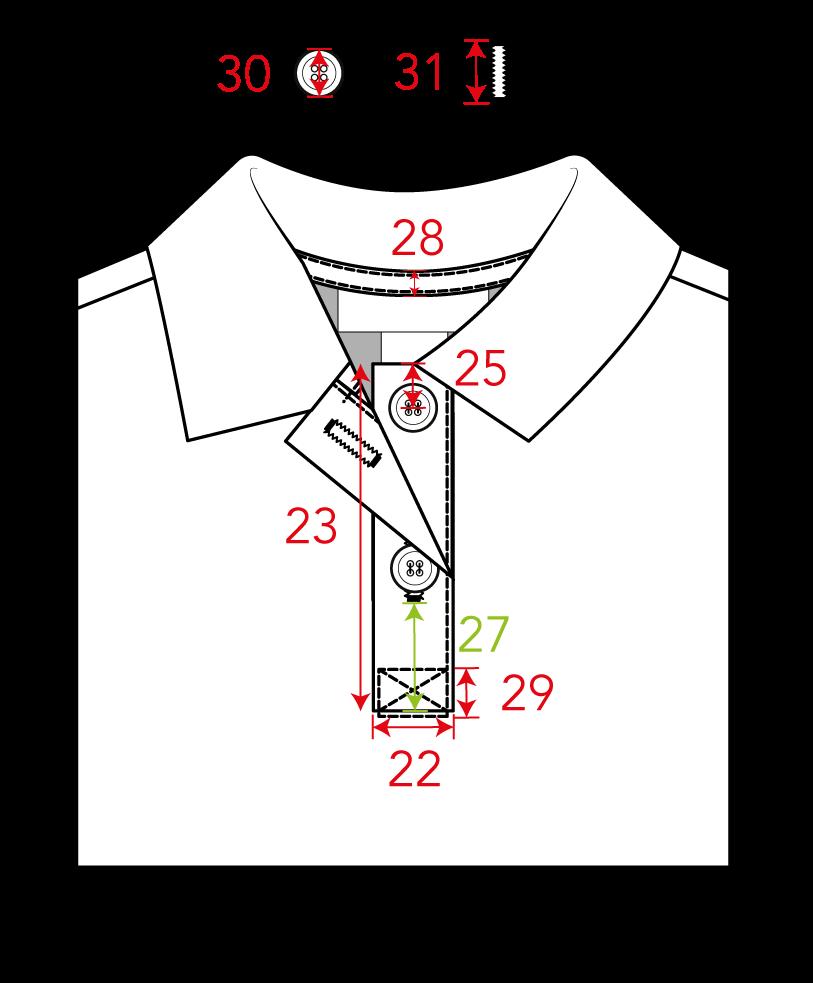

40
TOLERANCE +/- in mm
Collar neck circumference 35.5cm 2mm
Collar point 5cm 0mm
Collar spread 8cm 1mm 22 Placket width 2.5cm 1mm 23 Placket length - measured from front neck drop to edge of placked end 11.5cm 1mm 24 Placked end to first buttonhole 4.5cm 0mm
Distance from front neck point to first buttonhole 0.8cm 0mm
Distance between buttonholes 3cm 1mm
Height of lower buttonhole, measured up from placket end 1.5cm 1mm
Height of neck hole trim 1cm 0mm
Height of placket stitching 1.5cm 1mm
Button size 1.1cm 0mm
Buttonhole length 1.8cm 0mm
Slit measurements:
Slit length - measured from front hem to opening 3.2cm 2mm

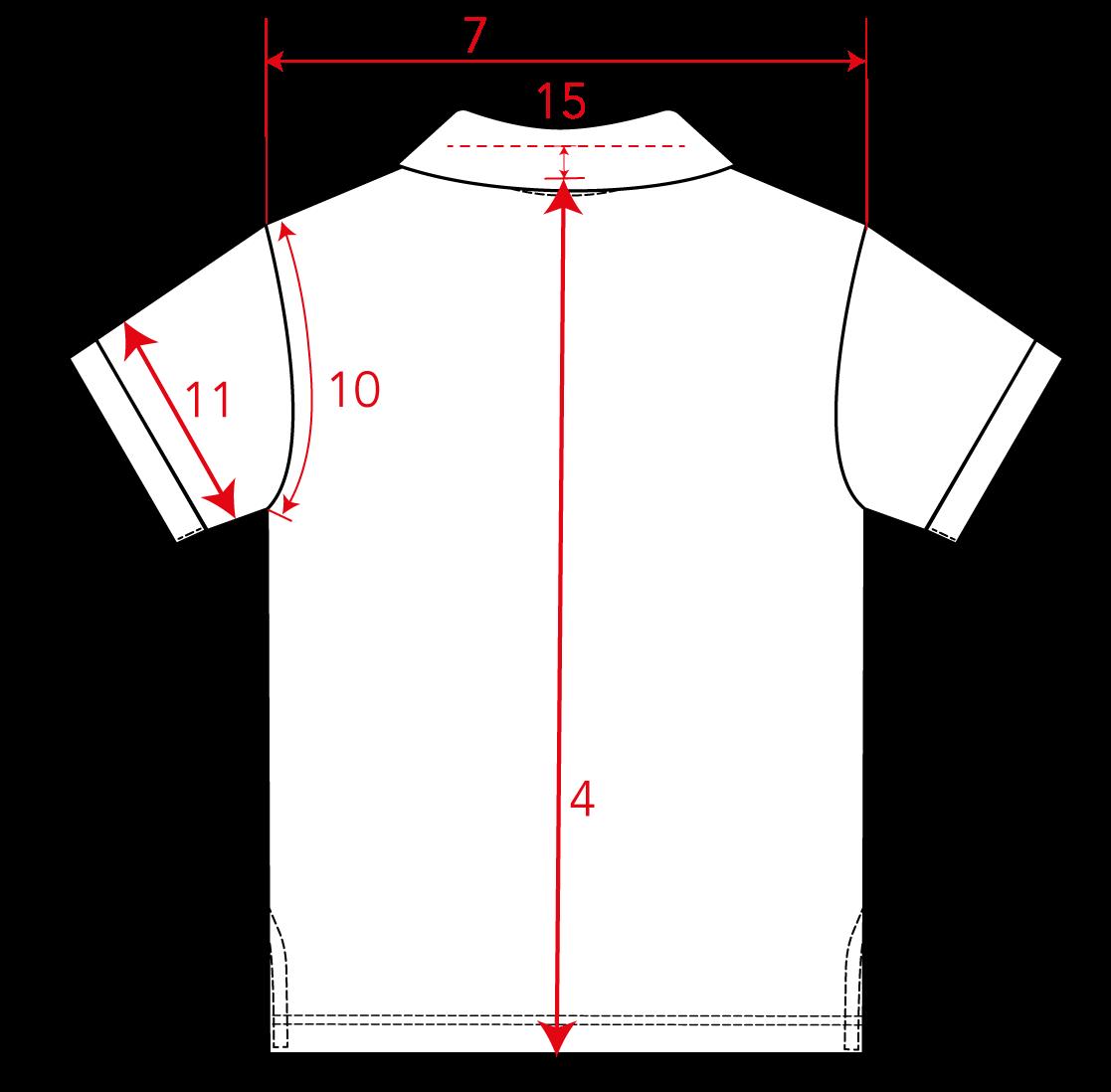
Hem height 1.5cm 1mm
Height of slit stitching 2cm 1mm
Height of care label from back hem from slit opening point 5cm 2mm
Trim width 1cm 0mm
Height of the embroidery from HPS/SNP on right front panel 12cm 2mm (Mountain, 2021)
Height of embroidery 2cm 0mm
Width of embroidery 1.3cm 0mm
Placement of embroidery from placket edge on right front panel 5.2cm 2mm
Composition
60% Cotton 40% Polyester Size 4-6Y
“Weft knitted fabric in cotton or blends, with small relief diamond pattern. Based on single jersey with regular tuck stitches. Often used for polo shirts” (Eberle, 2008)
Weft knitted fabrics can be made from a single yarn, which is fed crosswise to the length of the fabric to interlock the loops to create an either circular or flat weft knitted fabric.

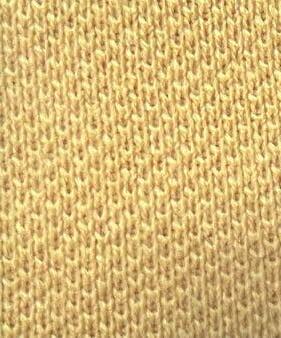
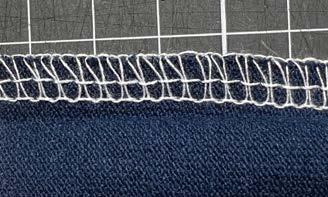
» 13 wales & 21 courses in 1cm (tight stitch tensions) » gauge number of about 30 - 40 (fine knit) » weights about 180g/m2 » priced at about 8,50 USD/kg (yarn dyed/stiped)

POLYESTER » polyester fibres balance the rather unfortunate characteristic » production is not affected by weather or climate » made from fossil resources » “harmful process and chemicals to the environment, wildlife and both the health of factory workers and people.” (Fashion Business Manual, p. 55, 2019)
+ breathable/ airy fabric + excellent ventilation and comfort during physical activity + less prone to wrinkle + only minimal amount of stretch, holds shape + good for embroidery (Silverbobbin, n.d.)
» Nm 90 - 120
» for needle numbers 10-14
» deliverey on 5000m cones
» in the colours: white/ petrol/ navy
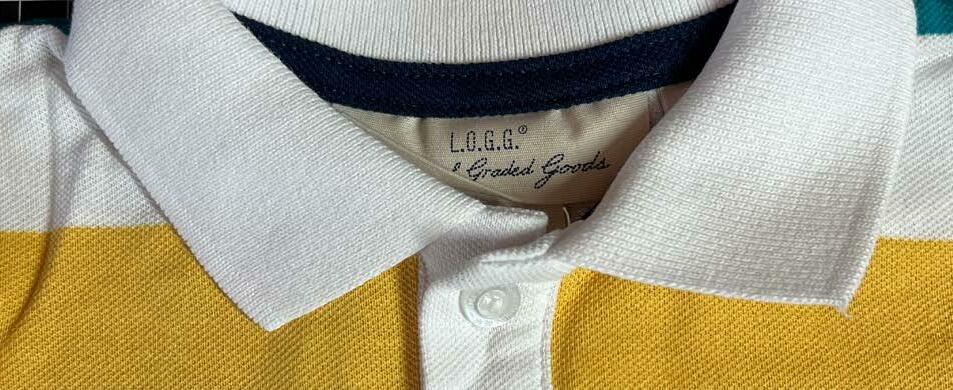

Possible manufacuterer: AMANN Bangladesh
Product: saba - POLYESTER/POLYESTER CORE

» Nm 80 - 110
» Tex no. 45
» deliverey on 5000m cones » in the colour navy
Possible manufacuterer: AMANN Bangladesh
1x1 RIB
“Alternating wales knitted on both front and back, with usually close up ribs, resulting in a double-faced fabric which has the same appearance on both surfaces. It is thicker and more elastic crosswise than lengthwise, and the edges do not curl. ” (Fashionpedia, 2017), making it perfect for the collar and the sleeve.
2 BUTTONS
(Eberle, 2014)
» Ø11mm white synthetic buttons with 4 holes » engraved with “ORIGINAL CASUAL WEAR - EST.1947”
+ cheapest + easiest to care + the 4 holes enable extra strength at the attachment, + a variety of shapes, sizes and colour + all exactly the same in large quantities
70 CM OF TRIMMING
» 1,5cm wide, folded and edged dark blue tape » made from same fabric as garment (knitted piqué) » attached on neckline and side slits
Covering
Product: Serafil - POLYESTER CONTINUOUS FILAMENT

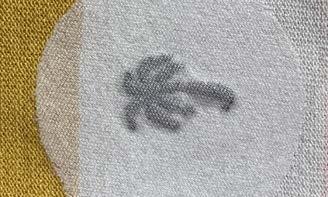
» woven with dot coating with PA or PES
» width: 150cm & weight 40g/m2 » in the colour white » 0.28 USD/m
» MOQ: 5000m
Possible manufacuterer: ZHEJIANG CHANGX ING CHANGRUI INTERLINING MANUFACTURE CO.,LTD, China
- satin woven printed labels - in the colour white - 0.03 USD/piece - moq: 1000 pieces
Possible manufacuterer: BORI GARMENT ACCESSORIES CO.,LTD., Bangladesh
LOGO & SIZE LABEL
» woven cotton labels » printed logo » in the colour beige/ navy » size: 1-100mm » 1 USD/dozen

Possible manufacuterer: BABLU GARMENTS & TAPELOOM IND., Bangladesh
HANGTAG » printed paper labels » in the colour white » 0.01 USD/piece » MOQ: 1000 pieces
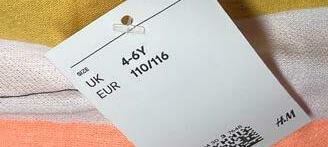
Possible manufacuterer: GLOBE LABELS, India


PACKAGING
- printed recycled plastic bag - transparent - 0.20USD/piece - moq 50000 pieces
Possible manufacuterer: FARIHA ACCESSORIES & TRADING INTERNATIONAL LIMITED, Bangladesh
“Fibre blending is used to improve perfomance, by compensating a weakness in the properties of a given fibre type, or to achieve special optical effects. Blending may also influence processing efficiency, yarn finess and cost.” (Eberle, 2004)
After harvesting the cotton seeds need to be dried, ginned and sorted by stable lengths. (Eberle, 2014)
Spinnable fibres with: » min stable length of 16mm » weight per unit 1-4 dtex

Spinned with melt-spinning process from a condensation polymer granulate by extruding through tiny holes of spineret into an airstream, which cools it.
The substance then gets drawn on heated rollers to be stretched, to align the molecules for stability. Getting compressed afterwards, to fold and crimp the filament.
Several filaments will be loosely drawn together to a tow, to be cutted into 3.2 -3.8 cm lenghts and ready to be blended with the cotton fibres.
(Hallett & Johnston, 2014)
(Textilepedia, 2020)
Fibres get blended during the stable yarn production to create already blended spun yarns, made by mechanical assembly and twisting them together into continuous length of interlocked fibres.
» strong/ fine/ smooth/ regular yarn
» suitable for all staple fibres
» large range of yarn count
» slow production rate - several processes and steps required

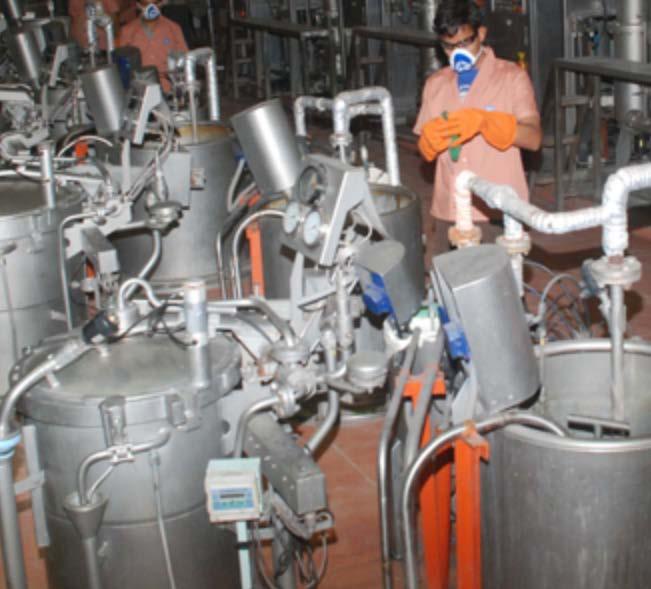
» processing: carded (low-cost production, fussy yarn for lightweight fabrics)
» yarn count: high
» direction: Z-twist
» level: low twist
» after fibres are spun into yarn & before they get knitted
» used for designs with multicoloured knitting patterns
» good colour fastness in wearing and washing
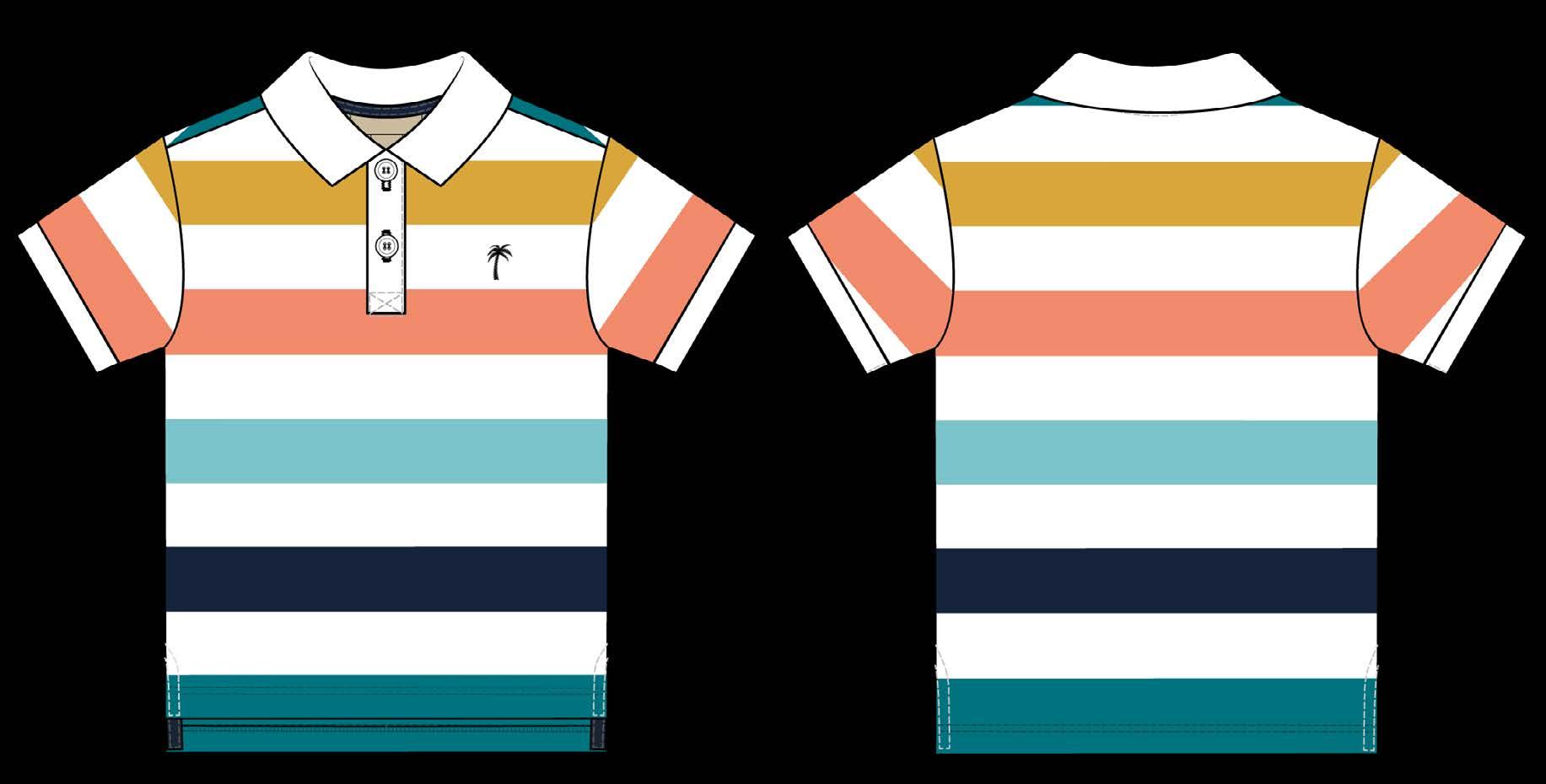
» more expensive than fabric-dyed (process takes longer)
» high MOQ
» can not respond to rapid fashion changes
(Hallett & Johnston, 2014)
“Commercially polyester/cotton blended fabrics are dyed by two-bath or one-bath two-step dyeing method employing suitable dyes and chemicals for each fiber. Two bath dyeing methods are relatively long and complicated. The one-bath two-step dyeing procedure is shorter as compared to two-bath method, but the drawbacks are lower dyeability and poor reproducibility.”
(Muralidharan & Laya, 2011)
(Textilepedia, 2020) COLOUR

(Textilepedia, 2020)
» machine knitted
» weft knitted
» gauge: 25-40
» tight slack tension
(Textilepedia, 2020)
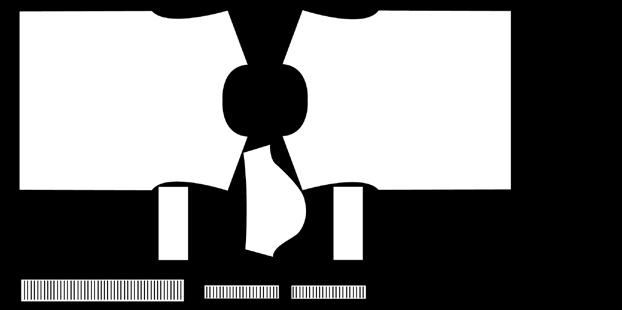
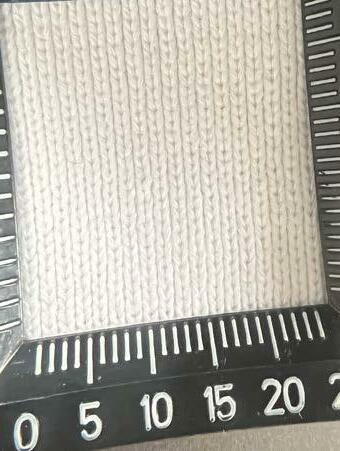
ALL CUT
» all garment pieces are cut from fabric
» completly sewn together
» for high production rates
» low costs
» high fabric waste
CIRCULAR BED
» creates tube-shaped pieces
» for large and fast productions
» used for finer knitwear (gauge <20)
» supports only all cut knit fabrics




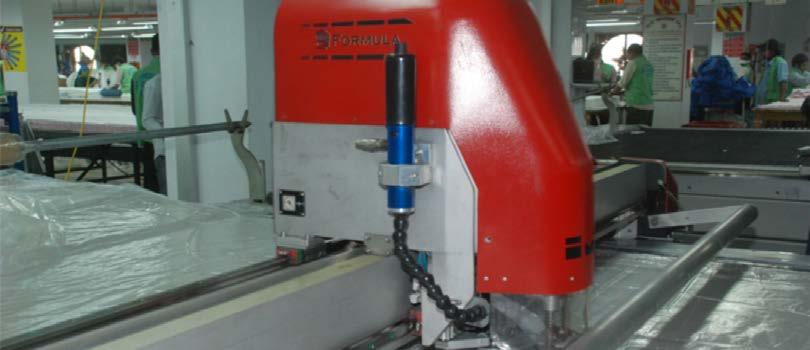


(Eberle, 2014)
Due to the stripe pattern and the leftright symmetry the pattern pieces can be placed parallel to the grain line, but either way.


The stripe pattern which is perfectly matching on side seams and on the yellow stripe with the sleeve requieres:
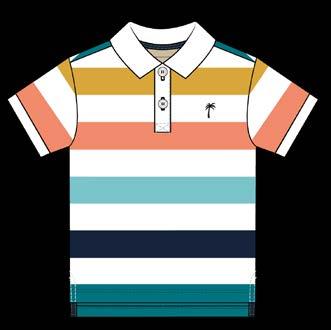
» precision for the fabric spreading process » cutting in two stages (1st rough cut & precise 2nd cut) » acknowledgement of the stripes in the layplanning » several checks for horizontal continuity
No distinct size section, pieces from two or more sizes are intermingeled.
Large number of fabric layers stacked evenly on top of the others.
+ best material utilisation
+ lowest cost
+ good for large amounts in even size quantities
The knitted piqué fabric will be delivered in a tubular form, then cutted open to use the full open width for easier pattern matching.
for lockstitch seams: 301 for overlock seams: 501 502/ 503 504/ 505 512/ 514 for flat seams: 406/ 407 602/ 605/ 607 for straight buttonholes in different shapes: machine square machine round radial straight eyelet taper
BUTTON



for button stitching: parallel stitching parallel & crosscover parallel & S-/ Z-crossover X-stitching X-stitching & crossover for bar tacks: spot tacks bar tacks









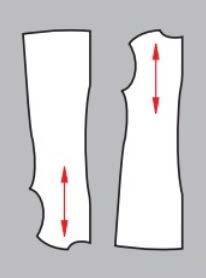
One-way spreading, so each layer of fabric is laid the same way up with the grain and stripes runing the same direction.
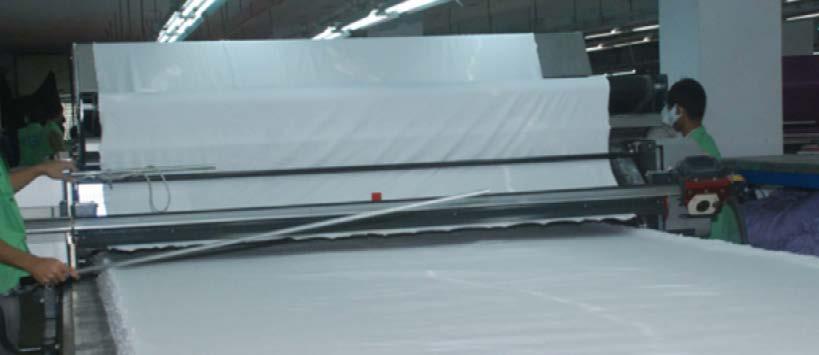

The fabric has to be cut after laying each ply.
1.01 ISO 6.02 8.02 7.32 3.05 7.25





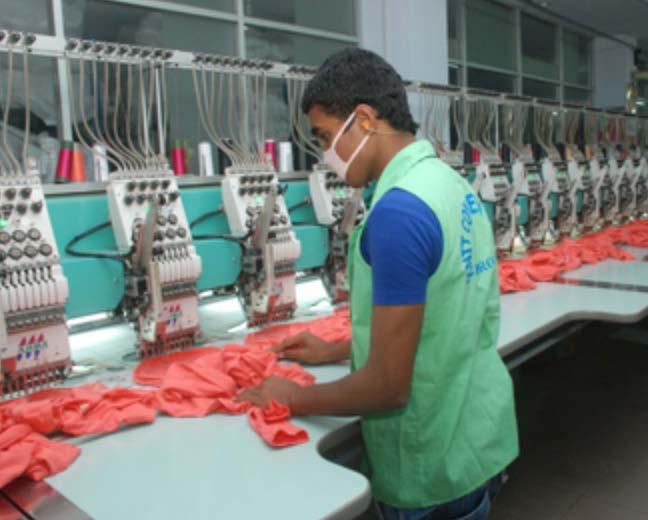
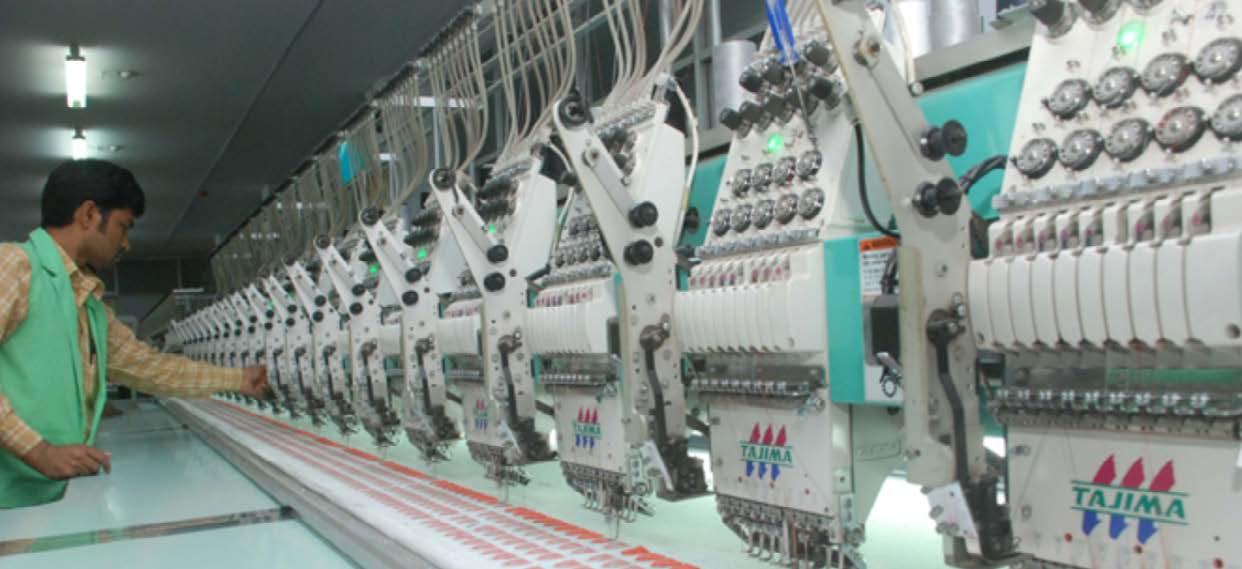
» surface decoration made by using threads and varios types of stitches with automated machines.

» “19 multi-head automatic embroidery machines and with the facilitiy of taping, cording, chenille, boring & all over & sequinces ...producing over 75 million stitches of embelishment a day” (The Knit Concern, 2019)
+ exactly the same on all shirts
+ fast and cheap process
+ low cost decoration
+ good choice for material (knitted piqué fabric)

IN-LINE & FINAL TABLE INSPECTION
» some quality tests during, but majority after the production process to check for any defects.
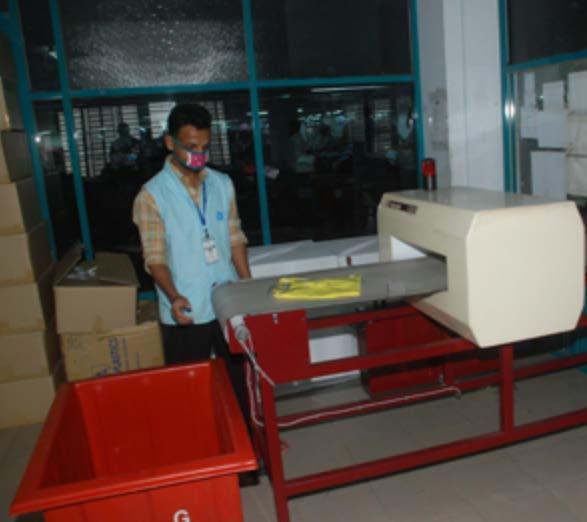
+ higher quality standards
+ easier to fix mistakes + sorting out all faulty products


Not every garment will be absolutly perfect in mass production, so the AQL determines the maximum percentage of defect items within a batch that will still be acceptable.


» important especially for kidswear, due to strict regulations for the childrens safety » tested for fibre properties, after care durabiliy and chemicals.
(Fashionary , 2019)
sizing - measurements, tolerances colour - dye spots, colour fastness fabric - fabric weight, treas, holes seams & stitching - stitch per cm, open seams, correct thread selection, loose thread ends, skipped stitches
appearance - visible marks, unfinished edges, stains fitting - same as approved sample

smell - unpleasent odors from dyes or other chemicals
safety - metal detectors for pins, needles and staples packaging & labelling - matching size & care labels, missing labels, incorrect label information
(Fashionary , 2019)
“To avoid damaging products before they reach a store, properly packing your collection is vital. Determining your clothings final retail display is one of the most important factors when deciding how to pack products for shipping.”
(Fashion Business Manual,p. 78, 2019)
» Folded garments in individual poly bags » easy method using the least space » all labels and barcodes attached » packed in cartons
» Depending on the route the products will take, restrictions and safety standards as well as weight & size for a carton should be considered.
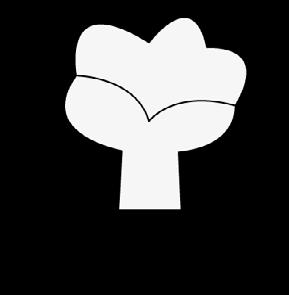

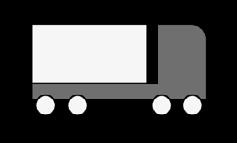


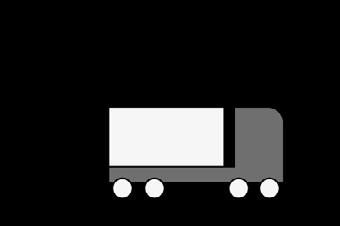
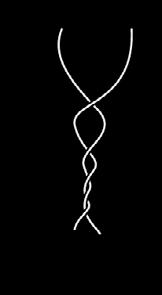

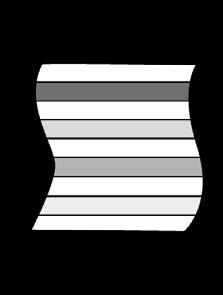






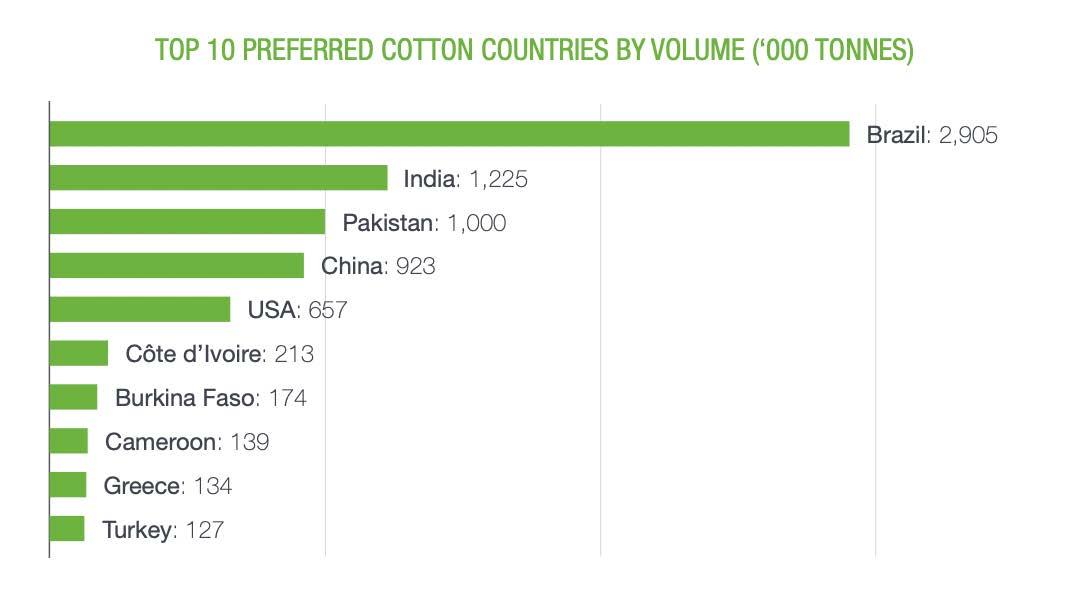

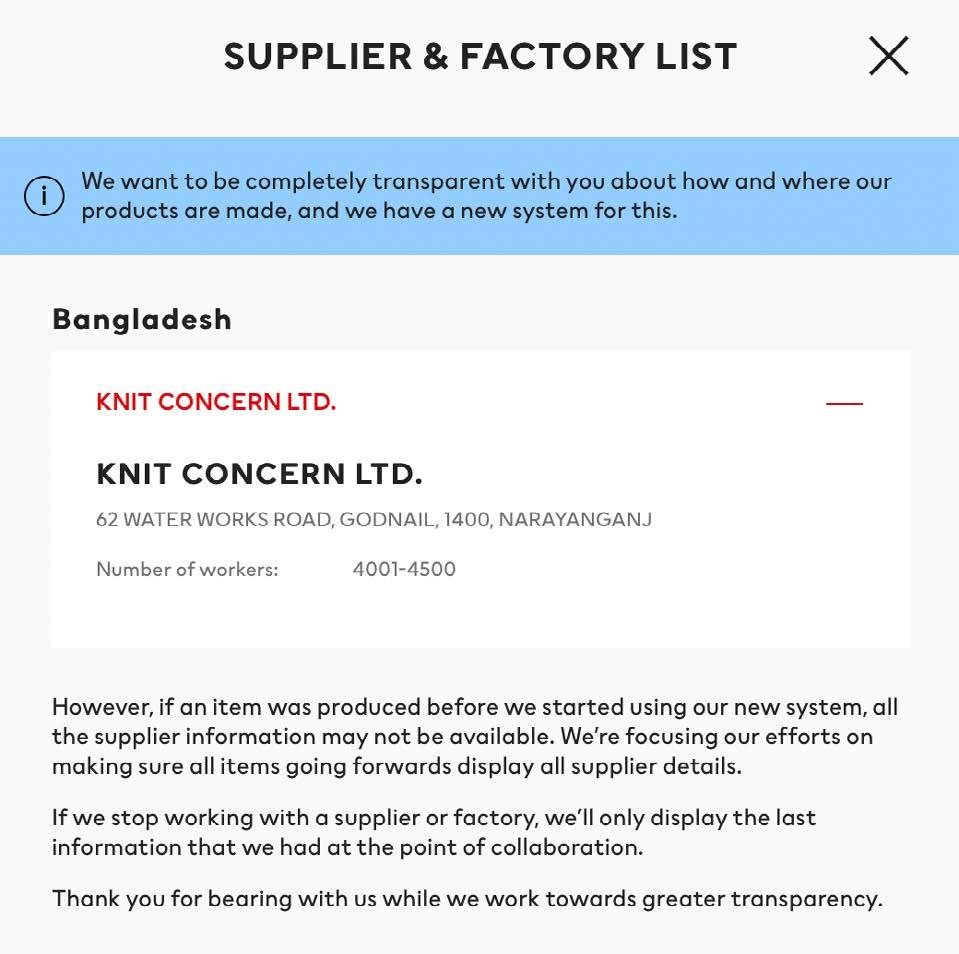


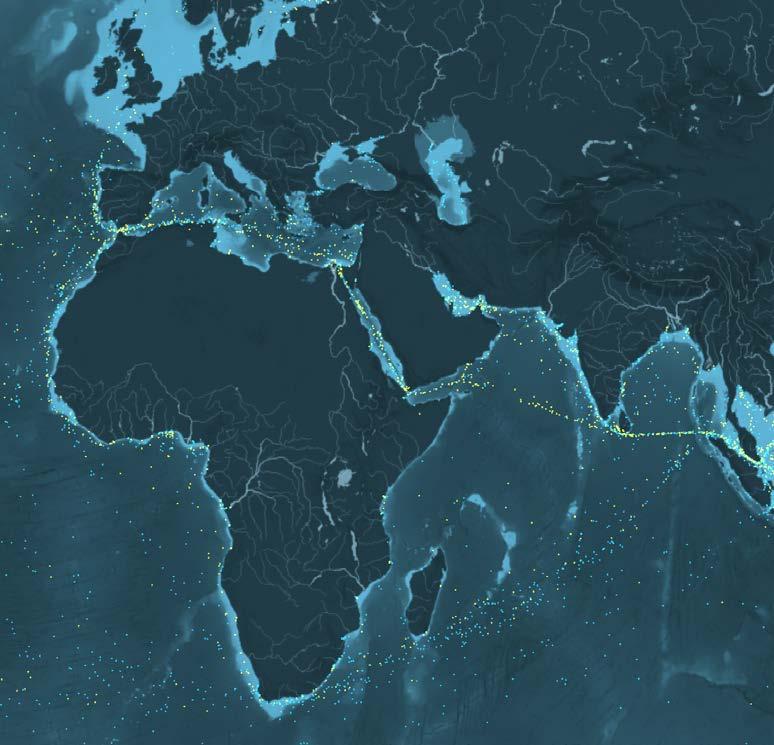


NO.
http://knitconcern.com
Location Address: 62 Water Works Road, Godnail, Narayangong – 1400, Bangladesh
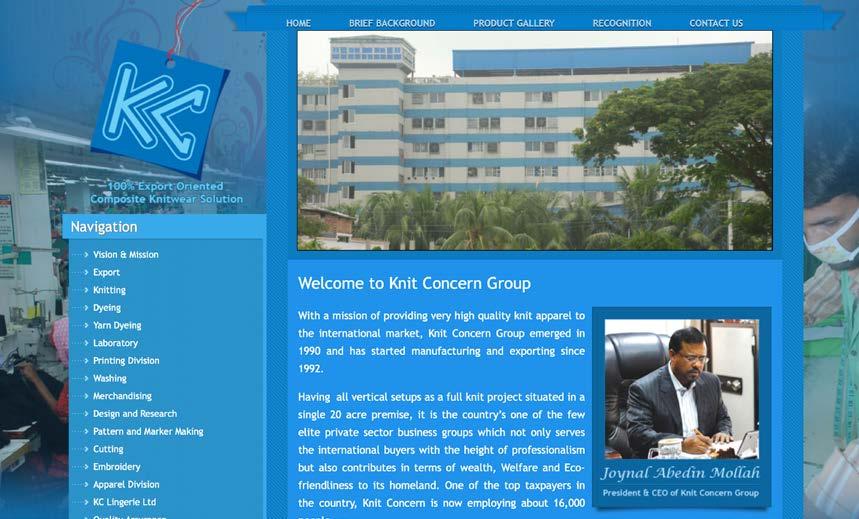
“Today, the company is an integrated Textile & Apparel manufacturing group with over 8500 staffs and annual exports of over US$ 70 million. They have three factories - Knit Concern, KC Apparels and KC Print which are catering well-known brands like H&M, Zara, Okaidi, Jacadi etc.” (Fong’s Engeneering, 2013) (Knit Concern, 2019)

» Philosophy focusing “on dedication to quality, commitment to excellence, adoption of state-of-the-art technology, and keen focus on customers’ satisfaction” (Knit Concern, 2019)
» Providing services from dyeing, to knitting, cutting, sewing and embroidery with productions of “150,000 pieces of knit apparel and 25,000 pieces of lingerie of latest quality and design every day.” (Textile Today, 2018)
» Location near a river and central in Asia makes transportation easy
» Advantage of the low cost of labor in Bangladesh compared to competitors in China, India, Cambodia, Sri Lanka, Vietnam, ... (CleanClothes, 2021)



» Information given on the care label - “Made in Bangladesh”
Sampling
Lap dip Fabric
Yarn Dyeing Production
Allocation
EVENT ACTION DATE LEAD TIME STAGE 1 Purchase Order raised 02.11.21 5 days PO 2 Lap dip revison, comments 08.11.21 3 days 3 Lap dip approval 11.11.21 4 days 4 Trim approval 15.11.21 2 days 5 1st Style and fit comments made 17.11.21 2 days 6 1st sample revison 19.11.21 5 days 7 2nd sample corrections/ comments 24.11.21 2 days 8 2nd fit correction 3.12.21 5 days 10 Final revision/ production of sample production 09.12.21 7 days 11 Final production sample approval 16.12.21 2 days 12 Spinning start date 18.12.21 5 days 13 Spinning end date 22.12.21 1 days 14 Yarn delievery to fabric production factory 23.12.21 3 days Transportation 15 Dyeing start date 27.12.21 4 days 16 Dyeing end date 31.01.22 1 day 17 Knitting start date 02.01.22 7 days 19 Knitting end date 09.01.22 1 day 20 Bulk fabric approved 10.01.22 1 days 21 Materials and trims delivered to garment factory 11.01.22 1 day 22 Spreading/ fabric cut day, bulk production start 12.01.22 3 days 23 Bulk cutting end 15.01.22 1 day 24 Sewing start 16.01.22 11 days 25 Sewing end 27.01.22 1 day 26 Embroidery start date 28.01.22 3 days 27 Embroidery end date 31.01.22 1 day 29 Finish - inspection and pressing start date 01.02.22 3 days 30 Finish - inspection and pressing end date 04.02.22 1 day 31 Packaging 05.02.22 2 days 32 Shipment start date 07.02.22 20 days 33 Shipment finish date / arrival at warehouse 28.02.22 2 days 34 Allocation to stores/ distribution centres 02.03.22 2 days 35 Launch day 07.03.22 Launch
» H&M manufacturing informations on the manufacuterer for this exact garment as part of the new transparency policy - “Knit Concern LTD”

» Normal working hours of Bangladesh people, acknowleding the Bangladesh Labour Law 2006 (amended 2013) - “No adult worker shall ordinarily be required or allowed to work in an establishment for more than eight hours in any day” and “every ... industrial establishment shall remain entirely closed for at least one and a half day in each week.”
» Offical bank holidays in Bangladesh, UK and Sweden (Fig.: 63) - Some dates might not correspond with the entiteld lead time, while the overall lead time might appear longer than normal, but this is due to the many holidays during December. (Jackson, 2022)
This section of the report connects the given information of the garment with the end use, advantages and disadvantages for the wearer, commercial acumen, like how decision on the garment can influence the costing and what to expect from the choice of location of the production. All in context to current industry standards, innovations and sustainability.

A DESCRIPTION OF YOUR GARMENT’S FIBRE(S) AND FABRIC; THEIR PROPERTIES AND HOW THESE RELATE TO ITS END USE.
Just like Maslow stated (1943) in his original “hierarchy of needs”, our physiological needs are the biological requirements for human survival and together with air, food, drink, shelter, warmth, sex and sleep, clothing is one of them. (McLeod, PhD, 2022)

But garments also have their own general requirements to fulfil to work as a wearable clothing:
» Every garment must fulfil the basic functions of protection, decoration and identification, relating them back to the different interactions between a body and clothing in different environments (Fig.: 67, Eberle, 2014).
» Concluding this the H&M boys polo shirt will have to work on a boys body in a warm and active summer environment.
» “The garments should fit properly, (not causing hazards for the wearer) and present an appearance appropriate to the wishes of the wearer.” (Eberle, p.48, 2014)
» The garments fit and sizes will be right for 4-6year old boys, without the sleeves being to long, the collar being to high or similar things. The design itself is a colourful variation of a standard polo shirt and so more likely enjoyed being worn.
» Just as Eberle (p.48, 2014) identifies: “Clothing should maintain its intended form and be sufficiently durable.”
» Garments that changes or completely looses the original shape can not maintain the original intentional, appearance and comfort levels.
» The polo shirt is made from a CO/PES blend and both these fibres are know for their high durability. In combination they have a high resistance to abrasion, shrinkage, colour fastness, perspiration, as well as dry and wet tearing and are easy to maintain. By following the intended aftercare the shirt will last a long time even with a lot of stress and dirt. (Fashionary, 2017)
» As for garment construction, H&M made sure that things that easily break or tear are strong, for example the side silt. It has a two layered trimming to attach around the whole slit, stitched on once around and fixated with a unusual large bar tack.
» The garment should remain a comfortable next-to-skin contact in the intended environment. In order to be “comfortable” clothing must interact with “the body and its surrounding microclimate through insulation, ventilation, moisture absorption and transport.” (Eberle, p. 48, 2014)
» A garment suitable for summer and hot European weather needs a good airflow, cooling the body. The specific knitting technique for a piqué fabrics creates the perfect mix between protecting the skin from UV radiation as well as enough spacing between the yarns to let air circulate. (Silver Bobbin, n.d.)
» The piqué is also an ideal choice for moderate sports and motions, giving the garment a little stretch without the use of elastane.
» The moisture will be absorbted a bit but also transported out before the shirt gets the uncomfortable “wet cling” effect.
» All labels and seams are soft without any unpleasant scratching, prickling or clinging. (Eberle, 2014)
» All tags and seams are soft without any unpleasant scratching, prickling or clinging.
» Maintaining the “shape and function through laundering and cleaning” (Eberle, p. 48, 2014) by following the given instructions on the care label.
» Following general washing rules like sorting garments according to washing instructions and colouration, as well as the dosage and descriptions of usage for detergents and washing machines, all garments have been tested to make them last as long and clean as possible.
» A lot of different factors play a role when choosing the most effective care instructions. From fibres to colouration, construction, details and finishes, all these things will react different to cleaning processes.
» White cotton can be boil washed, but the polyester can’t so a maximum wash of 40°C is appropriate, while the specific cotton/ polyester blend colouration forbids the use of bleach and will not work with the chemicals of dry cleaning processes. (Eberle, 2014)
All these things make the H&M boys polo shirt an ideal choice for an active young child. Research shows that cotton and polyester are the most popular fibres in the industry and though prices for raw material currently reach their highest in a decade (Hall, 2021), “they undoubtedly have great properties, which is why they have conquered the industry.” (Lüthi, 2021)
Another factor that should always be included in every decision on fibre and fabric nowadays is sustainability, in particular “making it circular”/ easy to reuse. Do the properties of a cotton/Polyester mix compensate the difficult chemical processes to separate them again for remanufacturing? (Blum, 2021) H&M does a good job with starting to think more sustainable, but it should start in every decision they make.
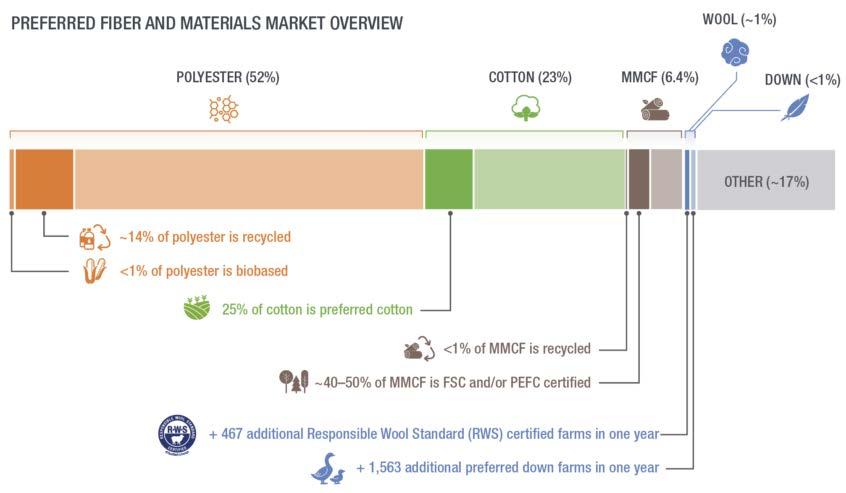
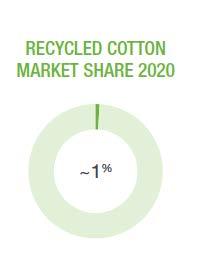
•
•
•
•
•
•
(Blum, 2021)
“Remanufacture: to put (a manufactured material or product) through a process of manufacture again; to manufacture from recycled material or parts.” Oxford Dictionary
Collection: in H&M Stores/ Deadstock
Identification & Inspection: what is the problem?
Disassembly: taking the garment apart
Reconditioning & Replacement: fixing or replacing the broken parts Reassembly: putting the garments back together
Quality assurance & testing: does it still meet the requirments?
Less waste and more use of resources after an enlongated product life cycle!
(TextileExchange, 2021)

Material Supplier
Fabrics
Pique Knit Group
Single Usage Units Price Per Cost

0.4 metre 1.56 £ 1 0.62 £
Rib Toray 0.1 metre 0.28 £ 1 0.03 £
Interlining Zhejang 0.05 metre 0.65 £ 1 0.03 £
Trims
Buttons Burman 2 piece 10.00 £ 1000 0.02 £
Trimming Knit Group 0.01 metre 1.56 £ 1 0.02 £
Care label Bori 1 piece 0.02 £ 1 0.02 £
Logo label Bablu 1 piece 0.80 £ 12 0.07 £
Size Label Bablu 1 piece 0.80 £ 12 0.07 £
Thread Amann 84.3 metre 15.00 £ 10,000 0.13 £
Hangtag Globe Labels 1 piece 0.01 £ 1 0.01 £
Polybag Fariha 1 piece 0.20 £ 1 0.20 £
Box Fariha 1 piece 1.00 £ 0.05 0.05 £
Barcode Fariha 1 piece 0.50 £ 0.05 0.03 £ 1.28 £
TOTAL MATERIALS PER GARMENT
LABOUR per dozen bundle
GIVE AN OVERVIEW OF THE GARMENT DESIGN, CONSTRUCTION, PRODUCT MANUFACTURING SYSTEMS , STAGES AND PROCESSES. HOW DOES THIS AFFECT THE COSTING, RETAIL SELLING PRICE AND WHAT COULD BE DONE TO REDUCE THIS IF REQUIRED.
As demonstrated in section 1, this garment was made by choosing a very specific set of attributes, processes and steps, which all effect the retail price.
But since material bought in large amounts tends to be really cheap, garment construction changes like stitch length or width as demonstrated in Figure 73 can make a huge difference in the amount of components needed. Although the amount of costing would only change the price at about £0.01 per shirt, while the strength and quality of the garment will be dramatically lowered (Fig.: 72).
Considering the large orders H&M needs, with 4,167 stores in 75 countries plus the 55 online markets (H&M, 2022) all stocking at least 4 shirts in every size, making them order this one shirt in this colourway and specific size about 20,000 times, making every pence quickly into £200.
Possible solutions to reduce the price:
STD.HRS 4 0.5 0.2
Operation per hour per 12 per single
3
Yarn Dyeing 0.50 £ 2.00 £ 0.17 £ Knitting 0.50 £ 0.25 £ 0.02 £ Lay & Cut 0.50 £ 0.10 £ 0.01 £ Sew & Make 0.50 £ 1.50 £ 0.13 £ Finish & Pack 0.5 0.25 £ 0.02 £
TOTAL 0.34 £
0.5 8.2 HOURS PER DOZEN
The most obvious way to reduce cost without losing any of the garment or quality aspects is to reduce the colours of the stripes. Yarn dyeing is a slow and expensive process (Textilepedia, 2020), and with 5 different colour needed on this shirt, an easy way without any major changes would be to create stripes in just 2 colours or even more by making it in only one colour, dyeing all fibres before spun to a yarn. Also speeding up the process of the lab dips significantly.
factory, equipments, managment, …
Factory Overhead Seconds, scrap
COST OF PRODUCTION
TOTAL COST OF MANUFACTURE Manufacturers Profit Wholesale Price / FOB Price Carriage, insurance, sea freight Quota, tax, import duty
Customes clearance, transport Reprocessing and RTM allowance UK import agency/ admin overhead
TOTAL LANDED COST PRICE
Retailer`s Profit Margin
SELLING PRICE (excluding VAT)
OVERHEADS 0.85 £ 2.48 £ 0.15 £ 3.48 £ 0.32 £ 3.80 £ 0.50 £ 0.26 £ 0.24 £ 0.16 £ 0.64 £ 3.80 £ 0.79 £ 6.39 £ VAT (20%) 1.60 £ 7.99 £
RETAIL PRICE (including VAT)
Another solution could be to increase the amount of polyester in the fibre blend up to 80% or even 100%. Keeping in mind that this would change a lot of the garments benefits as well as the wearing attributes rather unpleasantly, especially the high possibility of electrostatic charges could bother a child. (Fashionary, 2017)
One more possibility but with a larger change is to source form a different supplier growing/ producing the fibres in another country or changing the manufactures to a region with cheaper costs (Bangladesh already has low labour costs, getting payed less than the needed living wage. (Fig.: 58)) or rethinking the location in context to quicker and cheaper transportation. A change to a company with higher daily capacities and MOQ could also reduce costs. (Fashionary, 2019)
Some costs might never been seen in a calculation, for example currency fluctuations (Jackson& Shaw,2001), while others might not be related to the actual production of the garment but more with the transportation, insurances and import duties. With H&M’s international reach and the “complex nature of international freight forwarding, many retailers employ in-house experts to advice and control all aspects.” (Jackson& Shaw,p. 123, 2001)
Whatever choice will be made, the 3 main topics of the triple bottom line (Fig.: 74) should always be considered as an overall balanced scorecard. All businesses in the fashion industry have a major responsibility and all their actions should be measured in accounts by planet, people and price (Grose, 2021). And while the aim is to reduce the costs, making smart and profitable decisions about a responsible and sustainable use of resources and the environment as well as all the people involved is curcial. (The Economist, 2009)
Fig.: 71 shows an image of another kids polo shirt in H&M range for only £5.99 with visible less quality at the labelling, stitching and trims in only one colour, proving a reduce in cost is possible, but only with certain disadvantages. (H&M,2022)
From an ethical and sustainable viewpoint, reducing the cost of an already low priced shirt, cutting down on quality, while being made under extreme price pressure is a questionable decision for the future of the fashion industry. The take-make-dispose model is extremely harmful and wasteful. The goal should rather be “to think more deeply about the products we create, the waste we generate and our clothing consumption habits.” (Blums, p.15, 2021), investing in quality and a long product life, to be enjoyed by many kids and parents.
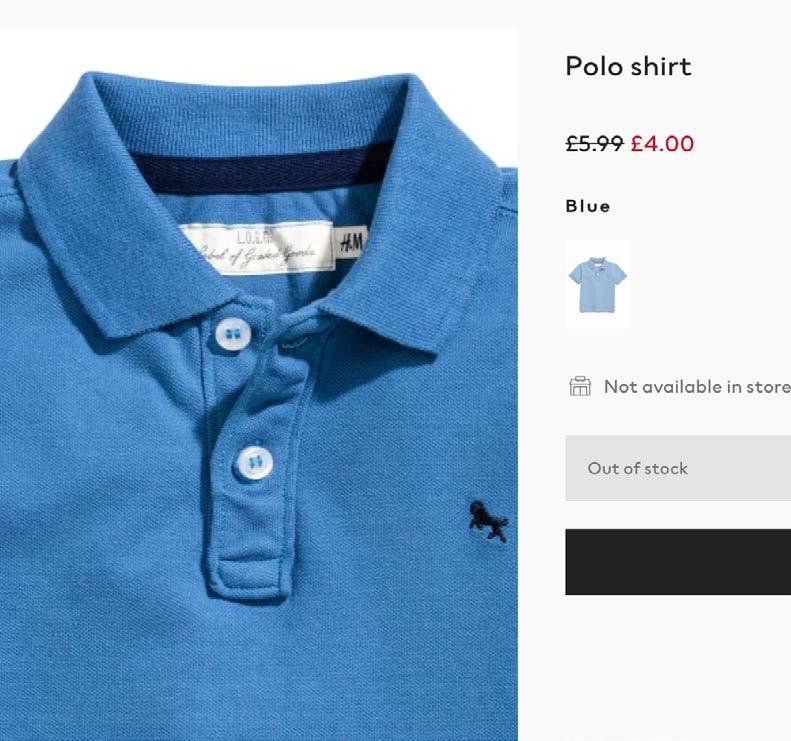
(Ganbold,
2020
IMAGINE PART OF YOUR JOB ROLE WAS BASED AROUND GLOBAL SOURCING. LOOK AT WHERE YOUR GARMENT HAS BEEN MADE. WHAT ARE THE BENEFITS AND LIMITATIONS OF CONTINUING TO MANUFACTURE GARMENTS IN THIS COUNTRY IN RELATION TO THE GLOBAL SUPPLY CHAIN AND SUSTAINABILITY?
With the high minimum wages in the UK and for processes that still need a lot of work done by hand, large retailers simply can not produce clothing local anymore. At least not at the low prices fashion consumers nowadays expect. The pressure to find cheaper manufacturing to keep prices low while maximising profits is higher than ever. “Global Sourcing often aims to procure the delivery of a product from low-wage economies in order to gain access to low-cost skilled labour, low-cost raw materials and other economic factors like tax breaks and low trade tarifs.” (Boardman, Parker-Strak & Henninger, p.117, 2020)
Bangladesh, especially the city Dhaka, is worldwide one of the cheapest places to manufacture garments, mostly due to the extremely low minimum wage as announced by the Bangladesh Government (Take-Profit, 2022) at “8100 BDT/ Month (93.46 USD/Month) in 2020” resulting in about 50 BDT/Hour (0.58USD/Hour). In combination with the “around 5,000 garment manufacturing firms in the country, employing more than 4,4 million people, 70% to 80% of whom historically have been women” (Khan, Islam and Wichterich, p.113, 2015), the business opportunities in textile and clothing are excellent, and this is expected to continue in the coming times. (Fong`s Engineering, 2013).
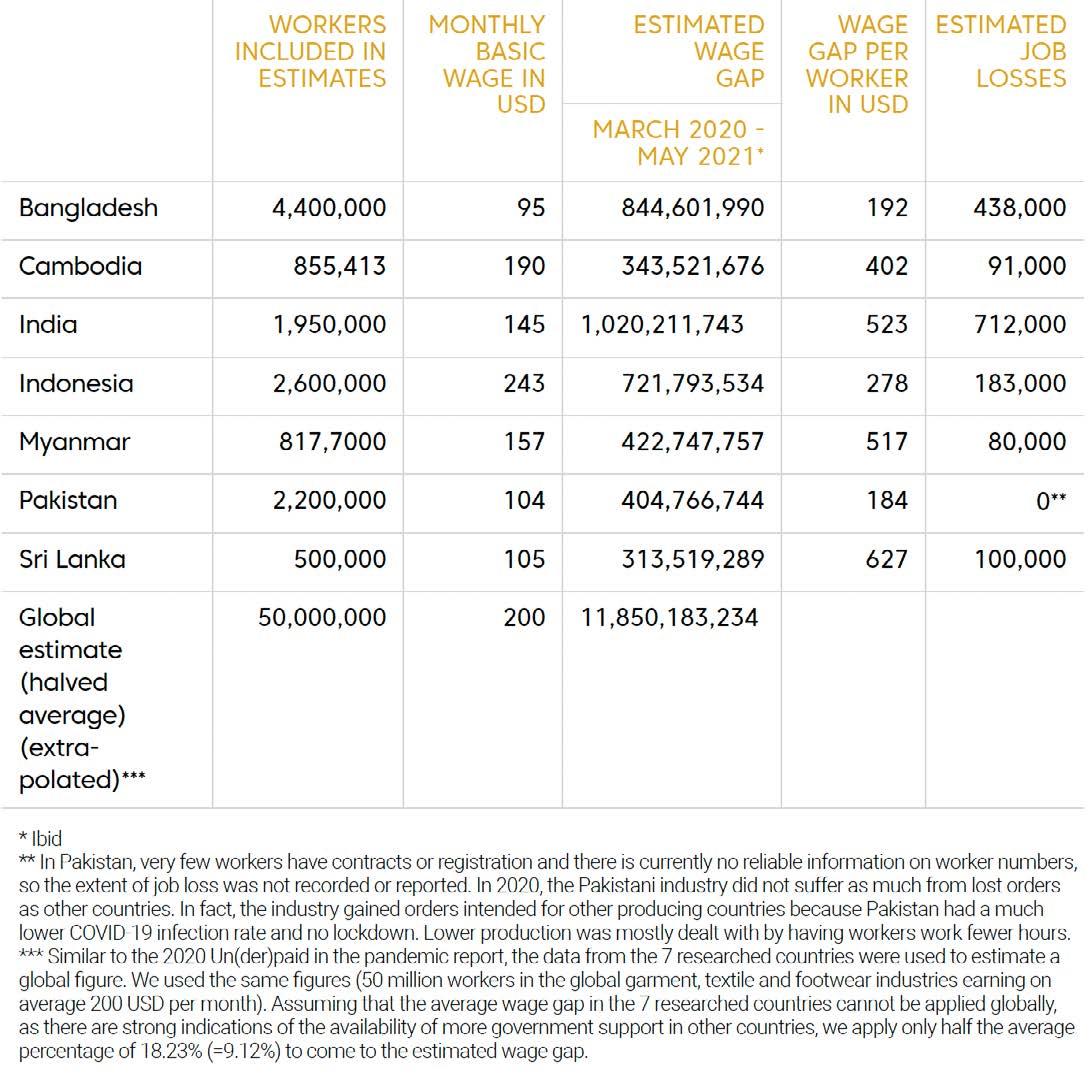

Being the second largest exporter of clothing in the world, behind China (Willem te Velde, Moazzem and Woodruff, 2014) with approximately 27.95 billion U.S. dollars export values at ready-made garments in 2020 (Fig.: 76) and the government supplementing with laws on further growth (DFS worldwide, 2022) as well as the manufactures dispositions to invest in high-quality machinery from world renounced companies (Mollah, 2016), Bangladesh obviously has its benefits as an offshore choice.
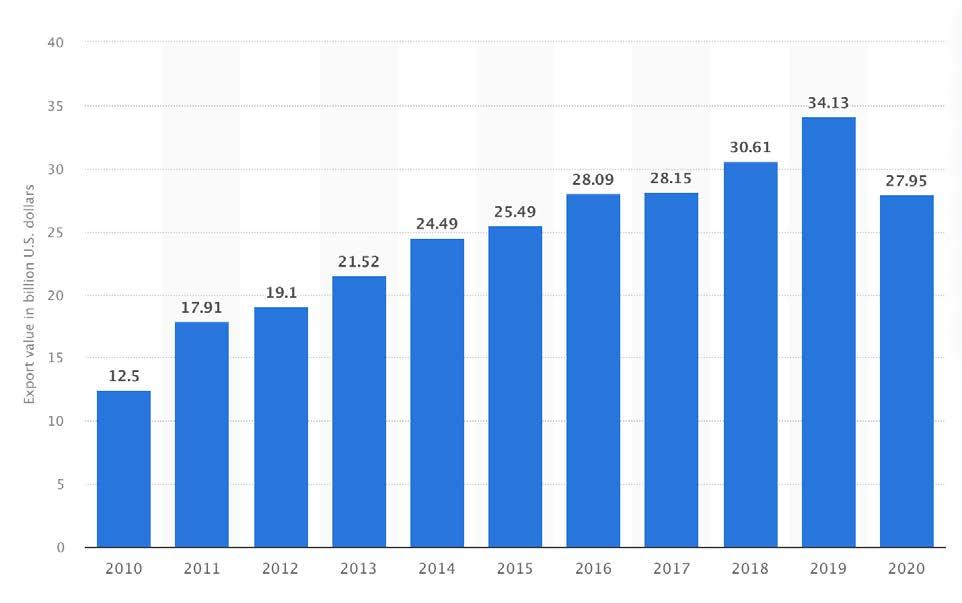
But with all the positive sides of Bangladesh’s garment industry, there are a lot of weaknesses and not just a few threats for a retailer. Challenges and disadvantages in a business relationship with Bangladesh include a lack of transparency, high corruption levels, short supply of gas and electricity up to major ethical issues.
Fig.: 58
Fig.: 75
“Actually, garment workers’ progress is like a nightmare. Even having those dreams is a curse for us the garment workers. Our salary is very low compared to the garment workers in the developed countries. Our standard of living is unbearable. We can barely make our living. We can only breathe. That’s our situation now. Our family, relatives, kids — those who are near to us — we can’t treat them properly. The dreams that we have, they turn into curses.”
-Mamun Faruk, quality inspector at garment factory, Bangladesh, December 2014
H&M (2022) states: “All our products are made by independent suppliers, often in developing countries where our presence can make a real difference. Our business helps to create jobs and independence, particularly for women — consequently lifting people out of poverty and contributing to economic growth. We only work with partners who share our respect for people and the environment, and who are willing to work with us to improve their practices. All suppliers and factories must sign our strict Sustainability Commitment, which includes requirements for fair wages and good working conditions for all. We employ dedicated sustainability staff in our worldwide production offices to make sure the commitment is followed.”
“Polo shirt in cotton piqué with a ribbed collar and button placket. Small embroidered detail on the chest, short sleeves with narrow trims, and short slits in the sides of the hem. Slightly longer at the back.” (H&M Product Describtion 2022)
- Standart fitted classic polo kids polo shirt
But according to several reports and researches from international labour, workers’ rights and local organisations, the reality still looks very different for majority of factory workers (Fig.: 75) and “supplier visits might not give a realists portrayal of worker´s everyday lives.” (Boardman, Parker-Strak & Henninger, p.121, 2020)
- Made out of a weft knitted piqué and rib knitted details like collar and sleeve hem - short attached button placket with two 4-hole plasitc bottons and (-----) buttonholes - ribbed collar, no collar stand, ribbon attached - woven brand and size label in the back neck, care label in side seam - the straight hem is shorter in the front with short side slits on both sides with 90° cor ners
- small emboidered palm three motiv on the right breast area
And even though non of the research can be related directly to H&M´s suppliers, quotes and statics like this make people doubt what the real working conditions are and how transparent H&M´s supply chain really is. (Fig.: 75, Fig.:58) A disaster like the Rana Plaza building collapse can easily be a huge damage to a brand´s reputation. (Love, Mountain, 2022)
The financial factors also play a big role in the decision making. Long lead times due to the great distance of manufacturing to distribution centres, make fast responses in a trend driven industry nearly impossible. Even the weather conditions, or current world affairs can cause major disruptions. “Absolut delivery dates can never be guaranteed, and late arrivals can have a serious negative impact on profits.” (Boardman, Parker-Strak & Henninger, p.119, 2020) And although the manufacturing costs might be cheaper, the non-transparent costs, like currency fluctuations, quota, transportation, taxes and duties can be easily forgotten, even when they often make up the majority of the total landed costs (Fig.: 72).
Another factor is the sustainability, especially in the long transportation either by air or sea. If nearshoring is not a possibility, smart green freight practice (Fig.: 77) should be used. “Ships are incredibly polluting. They emit sulphur dioxide, a pollutant linked to respiratory illnesses as well as carbon dioxide and methane. … If no preventive action is taken… emissions could increase by 50-250% by 2050.” (Blum, p.104, 2021) Some shipping companies already plan on becoming fully carbon neutral by using cleaner fuels as well as adapting to new technologies.
Product Development Project: Product Analysis of a child´s polo shirt by Mae Woelfle, N1011985
 Product Development Project: Product Analysis of a child´s polo shirt by Mae Woelfle, N1011985
Product Development Project: Product Analysis of a child´s polo shirt by Mae Woelfle, N1011985
Overall, the garment is of very good quality for its retail price. Efforts for extra strength and appealing optic were taken and design detail like the placket are executed nicely, so the shirt can be handed down to other children when grown out.

But this might be the only sustainable bit since the shirt is not yet part of H&M (2022) promise: “All polyester used in our products will be 100% recycled by 2025” or “We only source 100% recycled or more sustainably-sourced materials by 2030.”
But with only 3 years left to fulfil the goal, this might be a good time for some changes, especially for kids wear in large quantities and a supplier more than happy to adapt and expand for H&M. (Knit Group, 2019)
Especially the cotton/ polyester blend is still a big problem for recycling, the methods to separate them again involve a lot of chemicals, special machinery and expertise. (See appendix p. 22 for more information).
So if the goal is to make fashion more circular, 100% cotton might be a better choice in particular for a garment with a high level of detail and durability. Certifications, the use of organic cotton or recycled polyester could justify a slight rise of the retail price to about £9,99, enhancing the sustainability and a better use of resources.
• H&M, 2022. Cotton piqué polo shirt - Light orange/Striped - Kids H&M GB. [online] H&M. Available at: <https://www2.hm.com/en_gb/product page.0933591004.html> [Accessed 28 March 2022].
• Eberle, H., 2014. Clothing Technology. 6th ed. Berlin: Europa Verlag, pp.8-222.
• Kininmonth, J., 2021. (Lecture to Natural Fibres, Nottingham Trent University) 9th March 2022.
• Mountain, N., 2021. The Critical Path. [Lecture at Nottingham Trent University]. 18.October.
• Fashionary Team, 2020. Textilepedia. 1st ed. Hong Kong: Fashionary International Ltd.
• Fashionary Team, 2019. The Fashion Business Manual. 1st ed. Hong Kong: Fashionary International Ltd.
• TextileExchange, 2021. Preferred Fiber and Materials Market Report. Available at: <https://textileexchange.org/preferred-fiber-and-materials-market-re port/> [Accessed 5 May 2022].
• H&M. 2022. Polo shirt - Bright blue - Kids H&M GB. [online] Available at: <https://www2.hm.com/en_gb/productpage.0718081030.html> [Accessed 7 May 2022].
• Love, A., 2022. Costing in the fashion industry. [Lecture at Nottingham Trent University]. 07.March.
• Amann, n.d. stitch types & sewing thread requirement.. Amann Group, pp.5-9.
• TextileExchange, 2021. Preferred Fiber and Materials Market Report. Available at: <https://textileexchange.org/preferred-fiber-and-materials-market-re port/> [Accessed 5 May 2022].
Iberuptius aut occus. Itam quae porenda nis quias et alit qui destio cusdame quias ipsant qui iure volore int labo. Uciliquia asimod qui sim hilitio rruntum repudi odi toribus. Labo. Ucit fugit idel into dolores molor aut doluptae ernatibus sitionecae cum quatibu scitium faciam nihilli stiorene reruptatur? Officium, sitat autem volorrum qui doluptatet magnam nes es aut et mollatus adi doluptatet
• Silver Bobbin. n.d. What Is Piqué Knit Fabric?. [online] Available at: <https://silverbobbin.com/what-is-pique-knit-fabric/> [Accessed 28 April 2022].
• Fibre2Fashion, 2022. Interlinings : Fashion Garments( Denim, Casual, Knit, Suits ), 150 cm Suppliers - Wholesale Manufacturers and Suppliers For Interlin ings : Fashion Garments( Denim, Casual, Knit, Suits ), 150 cm Fibre2Fashion. [online] Fibre2fashion.com. Available at: <https://www.fibre2fashion.com/ clothingaccessories/interlinings-suppliers-16121707> [Accessed 6 May 2022].
• Hallett, C. and Johnston, A., 2014. Fabric for fashion. London: Laurence King Publishing, pp.22-60.
• Muralidharan, B. and Laya, S., 2011. A New Approach to Dyeing of 80 : 20 Polyester/Cotton Blended Fabric Using Disperse and Reactive Dyes. ISRN Materials Science, [online] 2011, pp.1-12. Available at: <https://www.hindawi.com/journals/isrn/2011/907493/> [Accessed 8 May 2022].
• Pantone, 2022. Kids Polo Shirt Colours. [image] Available at: <https://connect.pantone.com/#/picker?pantoneBook=pantonePastelsNeonsUncoated> [Accessed 6 May 2022].
• The Knit Concern, 2019. Knit Concern 100% Export Oriented Composite Knitwear Solution. [online] Knitconcern.com. Available at: <http://knitconcern. com> [Accessed 2 April 2022].
• Amann, n.d. stitch types & sewing thread requirement.. Amann Group, pp.5-9.
• Fashionary Team, 2017. Fashionpedia. 1st ed. Hong Kong: Fashionary International Ltd.
• Udale, J., 2014. Textiles and fashion: exploring printed textiles, knitwear, embroidery, menswear and womenswear. 2nd ed. London: Bloomsbury, p.126.
• Fongsengineering.com. 2011. Fong’s National Engineering Company Limited. [online] Available at: <http://www.fongsengineering.com/en-us/success_ stories/detail/9> [Accessed 1 May 2022].
• Textile News, Apparel News, RMG News, Fashion Trends. 2018. Knit Concern installed Fong’s new patented technology machine TECWIN. [online] Avail able at: <https://www.textiletoday.com.bd/knit-concern-installed-fongs-new-patented-technology-machine-tecwin/> [Accessed 1 May 2022].
• CleanClothes.org, 2019. Still un(der) paid. [table] Available at: https://labourbehindthelabel.org/report-still-underpaid-how-the-garment-industry-failedto-pay-its-workers-during-the-pandemic/ [Accessed 6 May 2022].
• Holidays, N. and Ltd., O., 2022. National Holidays in Sweden in 2022 Office Holidays. [online] Office Holidays. Available at: <https://www.officeholidays. com/countries/sweden/2022> [Accessed 2 May 2022].
• Jackson, T, & Shaw, D 2000, Mastering Fashion Buying and Merchandising Management, Bloomsbury Publishing Plc, London. Available from: ProQuest Ebook Central. [29 November 2021].
• Maslow, A., 1970. Motivation and Personality. 3rd ed. Harper & Brothers.
• McLeod, S., 2022. Maslow’s Hierarchy of Needs. [online] Simplypsychology.org. Available at: <https://www.simplypsychology.org/maslow.html> [Ac cessed 10 May 2022].
• Silver Bobbin. n.d. What Is Piqué Knit Fabric?. [online] Available at: <https://silverbobbin.com/what-is-pique-knit-fabric/> [Accessed 28 April 2022].
• Hall, C., 2021. Fashion’s Raw Material Price Rises Felt From New York to Karachi. [online] The Business of Fashion. Available at: <https://www.businessof fashion.com/news/global-markets/fashions-raw-material-price-rises-felt-from-new-york-to-karachi/> [Accessed 6 May 2022].
• Lüthi, M., 2021. Do you see world breaking away from cotton & polyester any time soon?. [online] Fibre2fashion.com. Available at: <https://www.fibre 2fashion.com/news/fibre-news/do-you-see-world-breaking-away-from-cotton-polyester-any-time-soon--272846-newsdetails.htm> [Accessed 6 May 2022].
• Blum, P., 2021. Circular fashion. 1st ed. London: Laurence King Publishing, pp.14-106.
• Miller, K., 2020. The Triple Bottom Line: What It Is & Why It’s Important. [online] Business Insights Blog. Available at: <https://online.hbs.edu/blog/post/ what-is-the-triple-bottom-line> [Accessed 13 May 2022].
• The Economist. 2009. Triple bottom line. [online] Available at: <https://www.economist.com/news/2009/11/17/triple-bottom-line> [Accessed 12 May 2022].
• Grose, V., 2021. A practical guide to the fashion industry: Concept to Consumer. 2nd ed. London: Bloomsbury visual arts.
• Boardman, R., Parker-Strak, R. and Henninger, C., 2020. Fashion Buying and Merchandising. Oxon: Routledge, pp.78-85.
• Take-Profit. 2022. Bangladesh Wages 2022 | Minimum & Average. [online] Available at: <https://take-profit.org/en/statistics/wages/bangladesh/> [Accessed 1 May 2022].
• Khan, Islam, M. and Wichterich, C., 2015. Safety and labour conditions: the accord and the national tripartite plan of action for the garment industry of Bang ladesh.. [online] Global-labour-university.org. Available at: <https://global-labour-university.org/fileadmin/GLU_Column/papers/no_212_Khan_and_Wichter ich.pdf> [Accessed 13 May 2022].
• Fongsengineering.com. 2013. Knit Concern Group. [online] Available at: <http://www.fongsengineering.com/en-us/success_stories/detail/9> [Accessed 29 April 2022].
• Willem te Velde, D., Moazzem, K. and Woodruff, C., 2014. enhancing productivity in Bangladesh’s garment sector. Growth research program. [online] UK Government. Available at: <https://assets.publishing.service.gov.uk/media/57a089dfed915d622c000435/60970_Bangladesh_garment_sector_essays.pdf> [Accessed 15 May 2022].
• Ganbold, S., 2020. Bangladesh: export value of ready-made garments 2020. [online] Statista. Available at: <https://www.statista.com/statistics/987707/ bangladesh-export-value-garments/> [Accessed 13 May 2022].
• Dfsworldwide.com. 2022. UK/Bangladesh Commercial Shipping 20/40f Container Sea & Air Freight. [online] Available at: <https://www.dfsworldwide.com/ Shipping-to-Bangladesh.html> [Accessed 13 May 2022].
• Mollah, J. The Textile Magazine. 2016. Knit Concern Group emerges Bangladesh leader in knitwear fabric making. [online] Available at: <https://www.indian textilemagazine.in/knit-concern-group-emerges-bangladesh-leader-in-knitwear-fabric-making/> [Accessed 6 May 2022].
• H&M, 2022. Cotton piqué polo shirt - Light orange/Striped - Kids H&M GB. [online] H&M. Available at: <https://www2.hm.com/en_gb/product page.0933591004.html> [Accessed 28 March 2022].

• Claeson, B., 2015. OUR VOICES, OUR SAFETY: Bangladeshi Garment Workers Speak Out. [online] Washington: International Labor Rights Forum. Available at: <https://laborrights.org/sites/default/files/publications/Our%20Voices,%20Our%20Safety%20Online_1.pdf> [Accessed 7 May 2022].
• Love, A.; Mountain, N., 2022. Ethics and sourcing. [Lecture at Nottingham Trent University]. 21. March.
• Smart Freight Centre. 2022. Reduce emissions Smart Freight Centre. [online] Available at: <https://www.smartfreightcentre.org/en/smart-freight-solu tions/> [Accessed 14 May 2022].
• H&M, 2022. Goals and ambition. [online] H&M Group. Available at: <https://hmgroup.com/sustainability/leading-the-change/goals-and-ambitions/> [Ac cessed 19 May 2022].
Fig.: 1
• Amann, n.d. stitch types & sewing thread requirement.. Amann Group, pp.5-9.
• Bcwsbd.org. n.d. Bangladesh Center for Workers Solidarity. [online] Available at: <https://www.bcwsbd.org/page> [Accessed 1 May 2022].
• Blum, P., 2021. Circular fashion. 1st ed. London: Laurence King Publishing, pp.14-106.
• Boardman, R., Parker-Strak, R. and Henninger, C., 2020. Fashion Buying and Merchandising. Oxon: Routledge, pp.78-85.
• Fibre2fashion.com. 2022. Polo shirt Manufacturers Polo shirt Suppliers. [online] Available at: <https://www.fibre2fashion.com/garments/SearchResult. aspx?Pid=340&P=Polo+shirt&Sid=36&S=Kids+Wear&Type=Suppliers> [Accessed 29 April 2022].
• Fibre2fashion.com. 2022. Polyester / Cotton Blend Yarn Suppliers - Wholesale Manufacturers and Suppliers For Polyester / Cotton Blend Yarn - Fibre2Fash ion. [online] Available at: <https://www.fibre2fashion.com/yarns/polyester-cotton-blend-yarn-suppliers-21195397> [Accessed 28 April 2022].
• Bosforustextile.com. n.d. Bosforus Textile Pique Knit Fabric. [online] Available at: <http://bosforustextile.com/pique_knit_fabric.html> [Accessed 28 April 2022].
Iberuptius aut occus. Itam quae porenda nis quias et alit qui destio cusdame quias ipsant qui iure volore int labo. Uciliquia asimod qui sim hilitio rruntum repudi odi toribus. Labo. Ucit fugit idel into dolores molor aut doluptae ernatibus sitionecae cum quatibu scitium faciam nihilli stiorene reruptatur?
• Fibre2fashion.com. 2021. Polyester yarn prices expected to drop in upcoming period: TexPro. [online] Available at: <https://www.fibre2fashion.com/news/ textile-news/polyester-yarn-prices-expected-to-drop-in-upcoming-period-texpro-273718-newsdetails.htm> [Accessed 5 May 2022].
Officium, sitat autem volorrum qui doluptatet magnam nes es aut et mollatus adi doluptatet
• Business of Fashion, 2021. State The State of Fashion 2022. [online] Available at: https://www.businessoffashion.com/reports/news-analysis/the-stateof-fashion-2022-industry-report-bof-mckinsey/ [Accessed 19 Feburary 2022].
• Claeson, B., 2015. OUR VOICES, OUR SAFETY: Bangladeshi Garment Workers Speak Out. [online] Washington: International Labor Rights Forum. Availa ble at: <https://laborrights.org/sites/default/files/publications/Our%20Voices,%20Our%20Safety%20Online_1.pdf> [Accessed 7 May 2022].
• Clean Clothes, 2015. Bangladesh Factsheet February 2015. [online] Clean Clothes Campaign. Available at: <https://cleanclothes.org/file-repository/re sources-publications-factsheets-bangladesh-factsheet-2-2015.pdf/view> [Accessed 1 May 2022].
• Clean Clothes Campaign. n.d. Poverty wages. [online] Available at: <https://cleanclothes.org/poverty-wages> [Accessed 1 May 2022].
• Dfsworldwide.com. 2022. UK/Bangladesh Commercial Shipping 20/40f Container Sea & Air Freight. [online] Available at: <https://www.dfsworldwide. com/Shipping-to-Bangladesh.html> [Accessed 13 May 2022].
• Dillon, S., 2022. The Fundamentals of Fashion Management. 2nd ed. New York: Bloomsbury.
• Eberle, H., 2014. Clothing Technology. 6th ed. Berlin: Europa Verlag, pp.8-222.
• Erol, S., 2016. The Impact of Distance and Narrow Waterway on Voyage Cost: Cost Formulation and Implementation on a Dry Bulk Carrier. [online] Re search Gate. Available at: <https://www.researchgate.net/publication/298427712_The_Impact_of_Distance_and_Narrow_Waterway_on_Voyage_Cost_ Cost_Formulation_and_Implementation_on_a_Dry_Bulk_Carrier> [Accessed 10 May 2022].
• Fashinza’s Blog Clothing Manufacturer Supplier Ethical & Sustainable Apparel’s. n.d. What Are The Different Types of Pique Knits and How To Use Them in Designing Clothes?. [online] Available at: <https://fashinza.com/textile/tips-for-fashion-brands/what-are-the-different-types-of-pique-knits-andhow-to-use-them-in-designing-clothes/> [Accessed 28 April 2022].
• Fashionary Team, 2020. Textilepedia. 1st ed. Hong Kong: Fashionary International Ltd.
• Fashionary Team, 2019. The Fashion Business Manual. 1st ed. Hong Kong: Fashionary International Ltd.
• Fashionary Team, 2017. Fashionpedia. 1st ed. Hong Kong: Fashionary International Ltd.
• Fibre2Fashion. n.d. Fibre! Fibre burning bright: State of fibres. [online] Available at: <https://online.fliphtml5.com/wokmg/hlwk/#p=22> [Accessed 5 May 2022].
• Fibre2Fashion, 2022. Interlinings : Fashion Garments( Denim, Casual, Knit, Suits ), 150 cm Suppliers - Wholesale Manufacturers and Suppliers For Interlin ings : Fashion Garments( Denim, Casual, Knit, Suits ), 150 cm Fibre2Fashion. [online] Fibre2fashion.com. Available at: <https://www.fibre2fashion.com/ clothingaccessories/interlinings-suppliers-16121707> [Accessed 6 May 2022].
• Fibre2fashion.com. 2021. Global fibre production likely to rise 34% by 2030: Textile Exchange. [online] Available at: <https://www.fibre2fashion.com/ news/fibre-news/global-fibre-production-likely-to-rise-34-by-2030-textile-exchange-276180-newsdetails.htm> [Accessed 5 May 2022].
• Fibre2fashion.com. 2022. Interlinings : Fashion Garments( Denim, Casual, Knit, Suits ), 150 cm Suppliers - Wholesale Manufacturers and Suppliers For Interlinings Fashion Garments( Denim, Casual, Knit, Suits ), 150 cm - Fibre2Fashion. [online] Available at: <https://www.fibre2fashion.com/clothingac cessories/interlinings-suppliers-16121707> [Accessed 6 May 2022].
• Fibre2fashion.com. 2022. Kid’s Polo shirt Suppliers - Wholesale Manufacturers and Suppliers For Kid’s Polo shirt - Fibre2Fashion. [online] Available at: <https://www.fibre2fashion.com/garments/kid-s-polo-shirt-suppliers-21194372> [Accessed 29 April 2022].
• Fibre2fashion.com. 2022. Kid’s Polo shirt Suppliers - Wholesale Manufacturers and Suppliers For Kid’s Polo shirt - Fibre2Fashion. [online] Available at: <https://www.fibre2fashion.com/garments/kid-s-polo-shirt-suppliers-21194372> [Accessed 29 April 2022].
• Fibre2fashion.com. 2022. Pique Fabric 220GSM, Dyed, Circular Knit Suppliers - Wholesale Manufacturers and Suppliers For Pique Fabric : 220GSM, Dyed, Circular Knit - Fibre2Fashion. [online] Available at: <https://www.fibre2fashion.com/fabrics/pique-fabric-suppliers-17130073> [Accessed 29 April 2022].
• Fongsengineering.com. 2011. Fong’s National Engineering Company Limited. [online] Available at: <http://www.fongsengineering.com/en-us/success_sto ries/detail/9> [Accessed 1 May 2022].
• Ganbold, S., 2020. Bangladesh: export value of ready-made garments 2020. [online] Statista. Available at: <https://www.statista.com/statistics/987707/ bangladesh-export-value-garments/> [Accessed 13 May 2022].
• Gordon, S., 2022.Quality Management Systems. [Lecture at Nottingham Trent University]. 25. April.
• Grose, V., 2021. A practical guide to the fashion industry: Concept to Consumer. 2nd ed. London: Bloomsbury visual arts.
• Grumbach, D., 2014. History of international fashion. Northhampton: Interlink books.
• Gwilt, A., 2020. A practical guide to sustainable fashion 2nd ed.. London: Bloomsbury Publishing USA
• Hall, C., 2021. Fashion’s Raw Material Price Rises Felt From New York to Karachi. [online] The Business of Fashion. Available at: <https://www.businessoffash ion.com/news/global-markets/fashions-raw-material-price-rises-felt-from-new-york-to-karachi/> [Accessed 6 May 2022].
• Hallett, C. and Johnston, A., 2014. Fabric for fashion. London: Laurence King Publishing, pp.22-60.
• Hart, J., 2022. Weft Knitted Garment Production Routes [Lecture at Nottingham Trent University]. 31. January.
• Hart, J., 2022. COMPONENTS, TRIMS & INTERLININGS [Lecture at Nottingham Trent University]. 14. February.
• Holidays, N. and Ltd., O., 2022. National Holidays in Sweden in 2022 Office Holidays. [online] Office Holidays. Available at: <https://www.officeholidays. com/countries/sweden/2022> [Accessed 2 May 2022].
• H&M, 2022. Code of Conduct. [online] H&M. Available at: <https://about.hm.com/content/dam/hm/about/documents/en/CSR/codeofconduct/Code%20 of%20Conduct_en.pdf> [Accessed 1 May 2022].
• H&M, 2022. Cotton piqué polo shirt - Light orange/Striped - Kids H&M GB. [online] H&M. Available at: <https://www2.hm.com/en_gb/product page.0933591004.html> [Accessed 28 March 2022].

• H&M, 2022. CSR Code of Ethics. [online] H&M. Available at: <https://about.hm.com/content/dam/hm/about/documents/en/CSR/Policies/Code%20of%20 Ethics%20business%20partners_en.pdf> [Accessed 1 May 2022].
• H&M. 2022. Polo shirt - Bright blue - Kids H&M GB. [online] Available at: <https://www2.hm.com/en_gb/productpage.0718081030.html> [Accessed 7 May 2022].
• H&M, 2022. Goals and ambition. [online] H&M Group. Available at: <https://hmgroup.com/sustainability/leading-the-change/goals-and-ambitions/> [Ac cessed 19 May 2022].
• Ilo.org. 2013. Bangladesh Bangladesh Labour (Amendment) Act, 2013 (Act No. 30 of 2013).. [online] Available at: <https://www.ilo.org/dyn/natlex/natlex4. detail?p_lang=en&p_isn=94286&p_classification=01.02> [Accessed 1 May 2022].
• Jackson, T, & Shaw, D 2000, Mastering Fashion Buying and Merchandising Management, Bloomsbury Publishing Plc, London. Available from: ProQuest Ebook Central. [29 November 2021].
• Khan, Islam, M. and Wichterich, C., 2015. Safety and labour conditions: the accord and the national tripartite plan of action for the garment industry of Bangladesh.. [online] Global-labour-university.org. Available at: <https://global-labour-university.org/fileadmin/GLU_Column/papers/no_212_Khan_and_ Wichterich.pdf> [Accessed 13 May 2022].
• Kininmonth, J., 2021. (Lecture to Natural Fibres, Nottingham Trent University) 9th March 2022.
• Kininmonth, J., 2021.Man-made (Manufactured) Fibres: Synthetics [Lecture at Nottingham Trent University]. 1.November.
• Knit Concern, 2019. Yarn Dyeing. [image] Available at: <http://knitconcern.com/yarn-dyeing.htm> [Accessed 3 May 2022].
• Kuehne + Nagel. 2021. Sustainability Report 2021. [online] Available at: <https://home.kuehne-nagel.com/-/company/sustainability-report-2021> [Accessed 14 May 2022].
Fig.: 1
• LinkedIn, 2022. Knit Concern LinkedIn Profile. [online] LinkedIn. Available at: <https://www.linkedin.com/company/knit-concern-ltd/?trk=public_pro file_experience-item_profile-section-card_subtitle-click&originalSubdomain=bd> [Accessed 22 April 2022].
• Lloydsbanktrade.com. n.d. Opening hours and bank holidays in Bangladesh - Business Environment - International Trade Portal International Trade Por tal. [online] Available at: <https://www.lloydsbanktrade.com/en/market-potential/bangladesh/opening-hours> [Accessed 1 May 2022].
• Love, A., 2022. Costing in the fashion industry. [Lecture at Nottingham Trent University]. 07.March.
• Love, A., 2021. Product development – Specification sheets [Lecture at Nottingham Trent University]. 8.November.
Iberuptius aut occus. Itam quae porenda nis quias et alit qui destio cusdame quias ipsant qui iure volore int labo. Uciliquia asimod qui sim hilitio rruntum repudi odi toribus. Labo. Ucit fugit idel into dolores molor aut doluptae ernatibus sitionecae cum quatibu scitium faciam nihilli stiorene reruptatur?
• Love, A., 2022. Introduction to weft knitting [Lecture at Nottingham Trent University]. 24. January.
Officium, sitat autem volorrum qui doluptatet magnam nes es aut et mollatus adi doluptatet
• Love, A.; Mountain, N., 2022. Ethics and sourcing. [Lecture at Nottingham Trent University]. 21. March.
• Lüthi, M., 2021. Do you see world breaking away from cotton & polyester any time soon?. [online] Fibre2fashion.com. Available at: <https://www.fibre 2fashion.com/news/fibre-news/do-you-see-world-breaking-away-from-cotton-polyester-any-time-soon--272846-newsdetails.htm> [Accessed 6 May 2022].
• Mashiata Group, 2022. Yarn Dyeing. [image] Available at: <http://www.masihata.com/gallery-mega.html#3> [Accessed 10 May 2022].
• Maslow, A., 1970. Motivation and Personality. 3rd ed. Harper & Brothers.
• McLeod, S., 2022. Maslow’s Hierarchy of Needs. [online] Simplypsychology.org. Available at: <https://www.simplypsychology.org/maslow.html> [Ac cessed 10 May 2022].
• Miller, K., 2020. The Triple Bottom Line: What It Is & Why It’s Important. [online] Business Insights Blog. Available at: <https://online.hbs.edu/blog/post/ what-is-the-triple-bottom-line> [Accessed 13 May 2022].
• Mountain, N., 2021. Introduction to Sustainability in the Global Fashion Industry Lecture. [Lecture at Nottingham Trent University]. 6. December.
• Mountain, N., 2021. The Critical Path. [Lecture at Nottingham Trent University]. 18.October.
• Mountain, N., 2022. Colouration. [Lecture at Nottingham Trent University]. 21. February.
• Muralidharan, B. and Laya, S., 2011. A New Approach to Dyeing of 80 : 20 Polyester/Cotton Blended Fabric Using Disperse and Reactive Dyes. ISRN Materials Science, [online] 2011, pp.1-12. Available at: <https://www.hindawi.com/journals/isrn/2011/907493/> [Accessed 8 May 2022].
• myfabrics.co.uk. 2022. POLO ME GOTS Plain Jersey Pique – pink Albstoffe Hamburger Liebe - Cotton Jerseyfavorable buying at our shop. [online] Available at: <https://www.myfabrics.co.uk/173-912h050-03_polo-me-gots-plain-jersey-pique-pink-albstoffe-hamburger-liebe.html> [Accessed 28 April 2022].
• Pantone, 2022. Kids Polo Shirt Colours. [image] Available at: <https://connect.pantone.com/#/picker?pantoneBook=pantonePastelsNeonsUncoated> [Accessed 6 May 2022].

• Preetha, S., 2021. Not Even the Bare Minimum: Bangladeshi Garment Workers’ Wages and the Responsibility of Canadian Brands. [online] Steelworkers Humanity Fund. Available at: <https://www.bcwsbd.org/uploads/Not%20Even%20Bare%20Minimum%202021%20Report.pdf> [Accessed 13 May 2022].
• Roots, S., 2019. Choosing Weight of Fabric - Polo Shirts Archives - Latest News. [online] Impact Trading. Available at: <https://www.impacttrading.co.uk/ blog-impact/?cat=35> [Accessed 28 April 2022].
• Savant. n.d. What is pique knit fabric?. [online] Available at: <https://sanvt.com/journal/what-is-pique-knit-fabric/> [Accessed 28 April 2022].
• Ship Map. 2019. Shipmap.org. [online] Available at: <https://www.shipmap.org> [Accessed 8 May 2022].
• Slideshare.net. 2013. Industrial Attachment undertaken at Knit Concern Group Limited. [online] Available at: <https://www.slideshare.net/furiousram page/industrial-attachment-undertaken-at-knit-concern-group-limited> [Accessed 1 May 2022].
• Smart Freight Centre. 2022. Reduce emissions Smart Freight Centre. [online] Available at: <https://www.smartfreightcentre.org/en/smart-freight-solu tions/> [Accessed 14 May 2022].
• Silver Bobbin. n.d. What Is Piqué Knit Fabric?. [online] Available at: <https://silverbobbin.com/what-is-pique-knit-fabric/> [Accessed 28 April 2022].
• Take-Profit. 2022. Bangladesh Wages 2022 Minimum & Average. [online] Available at: <https://take-profit.org/en/statistics/wages/bangladesh/> [Ac cessed 1 May 2022].
• TextileExchange, 2021. Preferred Fiber and Materials Market Report. Available at: <https://textileexchange.org/preferred-fiber-and-materials-market-re port/> [Accessed 5 May 2022].
• The Textile Magazine. 2016. Knit Concern Group emerges Bangladesh leader in knitwear fabric making. [online] Available at: <https://www.indiantex tilemagazine.in/knit-concern-group-emerges-bangladesh-leader-in-knitwear-fabric-making/> [Accessed 6 May 2022].
• Textile News, Apparel News, RMG News, Fashion Trends. 2018. Knit Concern installed Fong’s new patented technology machine TECWIN. [online] Available at: <https://www.textiletoday.com.bd/knit-concern-installed-fongs-new-patented-technology-machine-tecwin/> [Accessed 1 May 2022].
• The Economist. 2009. Triple bottom line. [online] Available at: <https://www.economist.com/news/2009/11/17/triple-bottom-line> [Accessed 12 May 2022].
• The Knit Concern, 2019. Knit Concern | 100% Export Oriented Composite Knitwear Solution. [online] Knitconcern.com. Available at: <http://knitconcern. com> [Accessed 2 April 2022].
• Udale, J., 2014. Textiles and fashion: exploring printed textiles, knitwear, embroidery, menswear and womenswear. 2nd ed. London: Bloomsbury, p.126.
• UK Government, n.d. Global Strategic Trends - The Future Starts Today. [online] Assets.publishing.service.gov.uk. Available at: <https://assets.publishing. service.gov.uk/government/uploads/system/uploads/attachment_data/file/771309/Global_Strategic_Trends_-_The_Future_Starts_Today.pdf> [Accessed 20 March 2022].
• Waite, A., 2022. Introduction to stitch types used in product apparel manufacture [Lecture at Nottingham Trent University]. 14. February.
• Waite, A., 2021. Global Sourcing. [Lecture at Nottingham Trent University]. 25.October.
• Waite, A., 2022. Introduction to seams used in garment manufacture. [Lecture at Nottingham Trent University]. 21. February.
• Wikipedia.org. 2022. Maslow’s hierarchy of needs - Wikipedia. [online] Available at: <https://en.wikipedia.org/wiki/Maslow’s_hierarchy_of_needs> [Ac cessed 13 May 2022].
• Willem te Velde, D., Moazzem, K. and Woodruff, C., 2014. enhancing productivity in Bangladesh’s garment sector. Growth research program. [online] UK Government. Available at: <https://assets.publishing.service.gov.uk/media/57a089dfed915d622c000435/60970_Bangladesh_garment_sector_essays.pdf> [Accessed 15 May 2022].
• Williams, G., 2015. Fashion China. New York: Thames & Hudson.
Iberuptius aut occus. Itam quae porenda nis quias et alit qui destio cusdame quias ipsant qui iure volore int labo. Uciliquia asimod qui sim hilitio rruntum repudi odi toribus.
Labo. Ucit fugit idel into dolores molor aut doluptae ernatibus sitionecae cum quatibu scitium faciam nihilli stiorene reruptatur?
Officium, sitat autem volorrum qui doluptatet magnam nes es aut et mollatus adi doluptatet

34. Prohibition of employment of children and adolescent
(1) No child shall be employed or permitted to work in any occupation or establishment.
(2) No adolescent shall be employed or permitted to work in any occupation or establishment unless- (a) a certificate of fitness in the prescribed form and granted to him by a registered medical practitioner is in the custody of the employer and (b) he carries while at work, a token giving a reference to such certificate.
(3) Nothing in this sub-section (2), shall apply to the employment of any adolescent in any occupation or establishment either as an apprentice or or the purpose or receiving vocational training
35. Prohibition of certain agreement in respect of children
Subject to the provisions of this chapter, no person, being the parent or guardian of a child, shall make an agreement, to allow the service of the child to be utilized in any employment.
36. Disputes as to age
(1) If any question arises as to whether any person is a child or an adolescent, the question shall, in the absence of a certificate as to the age fo inspector for decision to a registered medical practitioner.
(2) A certificate as to age of a person granted by a registered medical practitioner as mentioned in sub-section (1), shall be conclusive evidence as to age of the person to whom it relates.
41. Working hours for adolescent :
(1) No adolescent shall be required or allowed to work in any factory or mine, for more than five hours in any day and thirty hours in any week;
(2) No adolescent shall be required or allowed to work in any other establishment, for more than seven hours in any day and forty-two hours in any week.
(3) No adolescent shall be required or allowed to work in any establishment between the hours of 7.00 P.M and 7.00 a.m.
(4) If an adolescent works overtime, the total number of hours worked, including overtime shall not exceed-
(a) in any factory or mine, thirty six hours in any week;
(b) in any other establishment, forty eight hours in any week.
(5) the period of work of an adolescent employed in an establishment shall be limited to two shifts which shall not overlap or spread over more than seven and a half hours each.
(6) An adolescent shall be employed in only one of the relays which shall not, except with the previous permission in writing of the Inspector, be changed more frequently than once in a period of thirty days.
(7) The provisions of weekly holiday shall apply also to adolescent workers, and no exemption from the provisions of that section shall be granted in respect of any adolescent.
(8) No adolescent shall be required or allowed to work in more than one establishment in any day.
44. Exception in certain cases of employment of children :
(1) Notwithstanding anything contained in this chapter, a child who has completed twelve years of age, may be employed in such light work as not to endanger his health and development or interfere with his education; Provided that the hours of work of such child, where he is school going, shall be so arranged that they do not interfere with is school attendance.
(2) All provisions applicable to an adolescent workers under this chapter shall mutatis-mutandis apply to such child workers.
100. Daily hours :
No adult worker shall ordinarily be required or allowed to work in an establishment for more than eight hours in any day: Provid ed that, subject to the provisions of section 108, any such worker may work in an establishment not exceeding ten hours in any day.
102. Weekly hours : (1) No adult worker shall ordinarily be required or allowed to work in an establishment for more than for ty-eight hours in any week. (2) Subject to the provisions of section 108, an adult worker may work for more than forty-eight hours in a week: Provided that the total hours of work of an adult worker shall not exceed sixty hours in any week and on the average fifty-six hours per week in any year:
103. Weekly holiday:
An adult worker employed in an establishment55
(a) which is a shop or commercial establishment, or industrial establishment, shall be allowed in each week one and half days holiday and in factory and establishment one day in a week; (b) which is a road transport service, shall be allowed in each week one day’s holiday of twenty four consecutive hours; and no deduction on account of such holidays shall be made from the wages of any such worker.
109. Limitation of hours of work for women :
No women shall, without her consent, be allowed to work in an establishment between the hours of 10.00PM and 6.00 AM
114. Closure of shops, etc. :
(1) Every establishment which is shop or commercial or industrial establishment shall remain entirely closed for at least one and a half day in each week. (2) The one and half day on which establishments shall remain entirely closed, shall be fixed for each area by the chief Inspector.
115. Casual leave :
Every worker shall be entitled to casual leave the full wages for ten days in a calendar year, and such leave shall not be accumu lated and carried forward to the succeeding year: Provided that noting in this section shall apply to a worker employed in a tea plantation.
116. Sick leave
(1) Every worker other than a newspaper worker, shall be entitled to sick leave with full wages for fourteen days in a calendar year
118. Festival holidays
(1) Every worker shall be allowed in a calendar year eleven days of paid festival holiday.
(2) The days and dates for such festivals shall be fixed by the employer in such manner as may be prescribed.
(3) A worker may be required to work on any festival holiday, but two day’s additional compensatory holidays with full pay and a substitute holiday shall be provided for him in accordance with the provisions of section 103.
124. Wages to be paid in current coin or currency notes :
All wages shall be paid in current coin or currency notes or bank cheque.
138. Establishment of Minimum wages Board :
(1) The Government shall establish a board to be called the minimum wages board.
139. Recommendation of minimum rates of wages for certain workers :
(1) Where, in respect of any industry, the Government is of the opinion that, in view of the prevailing rates of wages of workers en gaged in that industry, it is reasonable and necessary to fix the minimum rates of wages for all or any class of workers employed in such industry, it may direct the wages Board to 66 recommend, after such enquiry as the wages board thinks fit, the minimum rates of wages for such workers or class of workers.
140. Power to declare minimum rates of wages
(1) Upon receipt of a recommendation of the wages board under section 139, the Government may, by notification in the official Gazette, declare that the minimum rates of wages recommended by the wages board for the various workers shall, subject to such exception as may b e specified in the notification, be the minimum rates of wages for such workers.
This Code of Conduct is applicable to all suppliers, their subcontractors and other business partners that do business with H&M Hennes & Mauritz AB (publ.), registered in Sweden, corporate organisation number 556042-7220, or any other company, wholly or partly owned, directly or indirectly, by H&M Hennes & Mauritz AB (“H&M”).
H&M’s business concept is to offer fashion and quality at the best price. Quality also means that our products must be manufactured in a way that is environ mentally and socially sustainable. We have a responsibility towards everyone who contributes to our success. We are therefore committed to working closely with our suppliers and business partners to achieve a long-term, sustainable social and environmental standard in the factories that manufacture H&M’s products and in the operations of other business partners.
We base our requirements mainly on internationally agreed standards such as the Universal Declaration of Human Rights, The UN Convention on the Rights of the Child and applicable ILO Conventions, as well as national legislation.
Our general rule is that all our suppliers and other business partners must, in all their activities, follow the national laws in the countries in which they operate. Should any requirement in this Code conflict with the national law in any country or territory, the law must always be followed. In such cases the supplier must notify H&M immediately, before signing this Code.
However, H&M’s requirements may go beyond the requirements set out in national law.
2. CHILD LABOUR IS NOT ACCEPTED (Refer to ILO Conventions 138 and 182 and to the UN Convention on the Rights of the Child)
2.1 Child Labour H&M does not accept child labour. No person shall be employed at an age younger than 15 (or 14 where the national law so allows) or younger than the legal age for employment if this age is higher than 15. The company must take the necessary preventive measures to ensure that it does not employ anyone below the legal age of employment.
2.2 Young Workers All legal limitations on the employment of persons below the age of 18 years must be followed.
4.
4.1 Basic Rights
4.1.3 Every employee shall be treated with respect and dignity. Under no circumstances do we accept the use by our suppliers, their subcontractors or other business partners of humiliating or corporal punishment, and no employee shall be subject to physical, sexual, psychological or verbal harassment or abuse. 4.1.4 All employees have the right to form or join associations of their own choosing, and to bargain collectively. H&M does not accept disciplinary or discrim inatory actions from the employer against employees who choose to peacefully and lawfully organise or join an association.
(Refer to ILO Conventions 87, 98 and 135)
4.2 Wages, Benefits, Working Hours and Leave As background to this chapter we quote from the Universal Declaration of Human Rights Article 23:3, as guidance concerning our ambition for our suppliers and business partners: “Everyone who works has the right to just and favourable remuneration ensuring for himself and his family an existence worthy of human dignity...”
4.2.1 Wages must be paid regularly, on time, and must reflect the experience, qualifications and performance of the employee. H&M’s minimum requirement is that employers shall pay at least the statutory minimum wage, the prevailing industry wage or the wage negotiated in a collective agreement, whichever is higher. All other types of legally mandated benefits and compensations shall be paid. No unfair deductions are allowed, and the employee has the right to a written specification of how the wage has been calculated.
8.1 Transparency and Co-operation
H&M expects all its suppliers and other business partners to respect this Code of Conduct and to actively do their utmost to achieve our standards. We also expect our suppliers and other business partners to be transparent and not intentionally mislead our auditors. We believe in co-operation and we are willing to work with our suppliers and other business partners to achieve sustainable solutions and to promote suppliers and other business partners who are in compliance.
Ethical behaviour is required by H&M’s auditors and any breaches of H&M’s Code of Ethics must immediately be reported to H&M’s local management or to CoE@hm.com.
8.2
All suppliers and other business partners are obliged to keep H&M informed at all times of where each product is being produced, including subcontracting and homework. Relevant documentation must be maintained for auditing purposes. We reserve the right to make unannounced visits to all units producing goods or services for H&M, at any time. We also reserve the right to appoint an independent third party of our choice to conduct audits in order to evaluate compliance with our Code of Conduct. H&M is a member of the FLA, which randomly carries out unannounced audits on behalf of H&M. During audits we require unrestricted access to all areas of the premises, to all documents and to all employees for interviews. We also demand the right to provide employees with contact details for H&M.
H&M’s audits aim to identify gaps between the requirements in this Code of Conduct and the actual practices and conditions in the workplace. The audited company will usually be given the opportunity to propose and implement a corrective action plan. H&M will follow up the implementation of the plan and verify that violations have been remedied. A supplier failing to undertake sustainable improvements within the stipulated time frame would seriously damage its relationship with H&M. Unwillingness to cooperate or repeated serious violations of H&M’s Code of Conduct and local law may lead to reduced business and ultimately termination of the business relationship with H&M.





